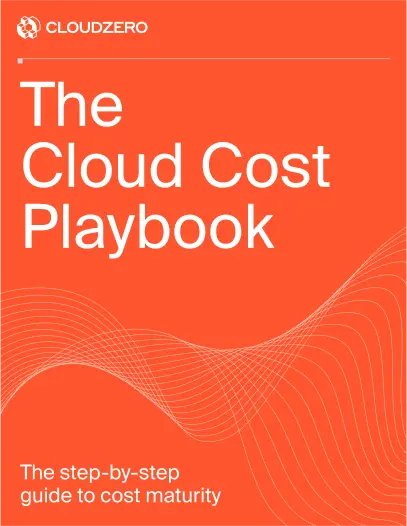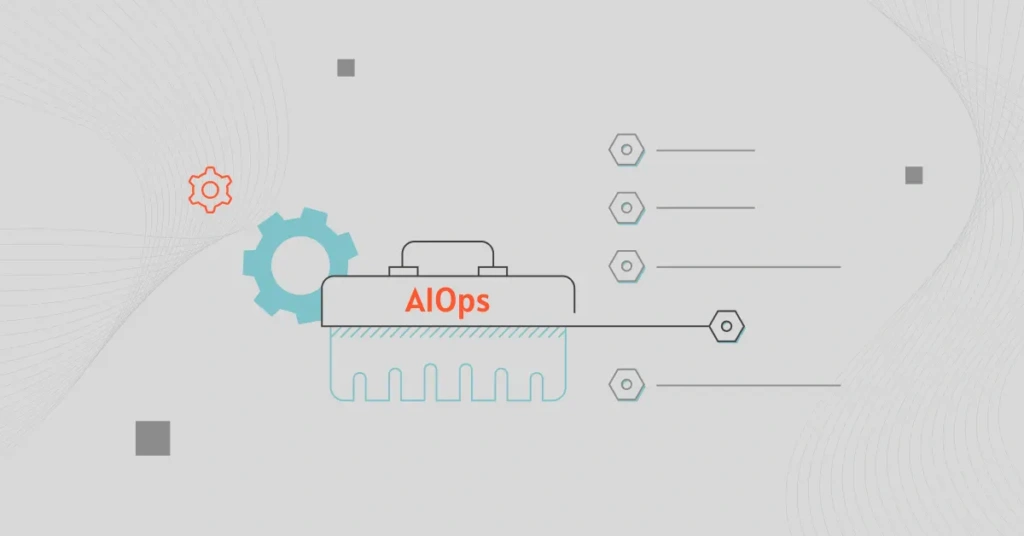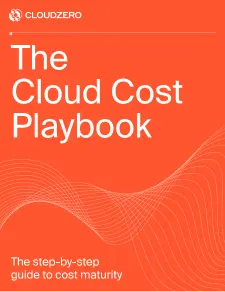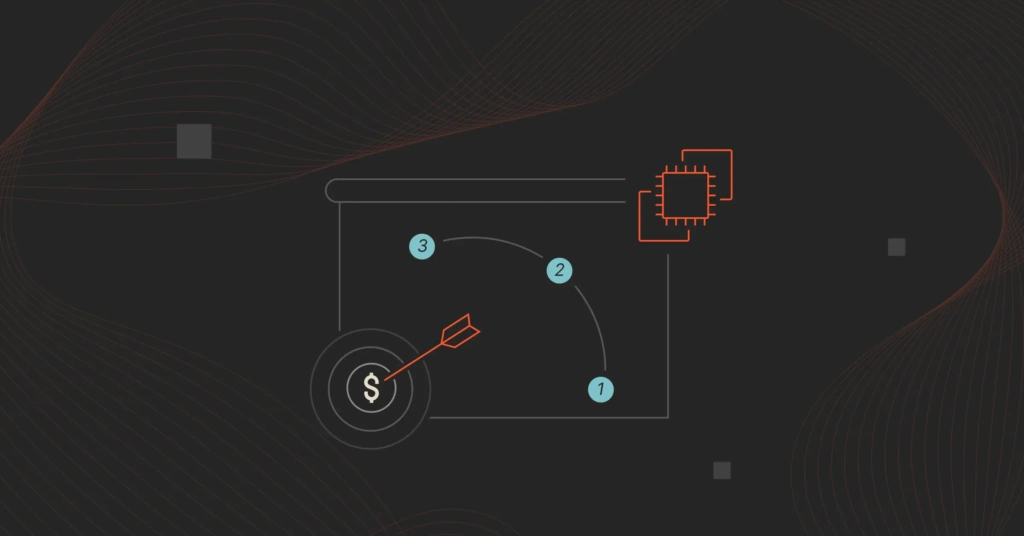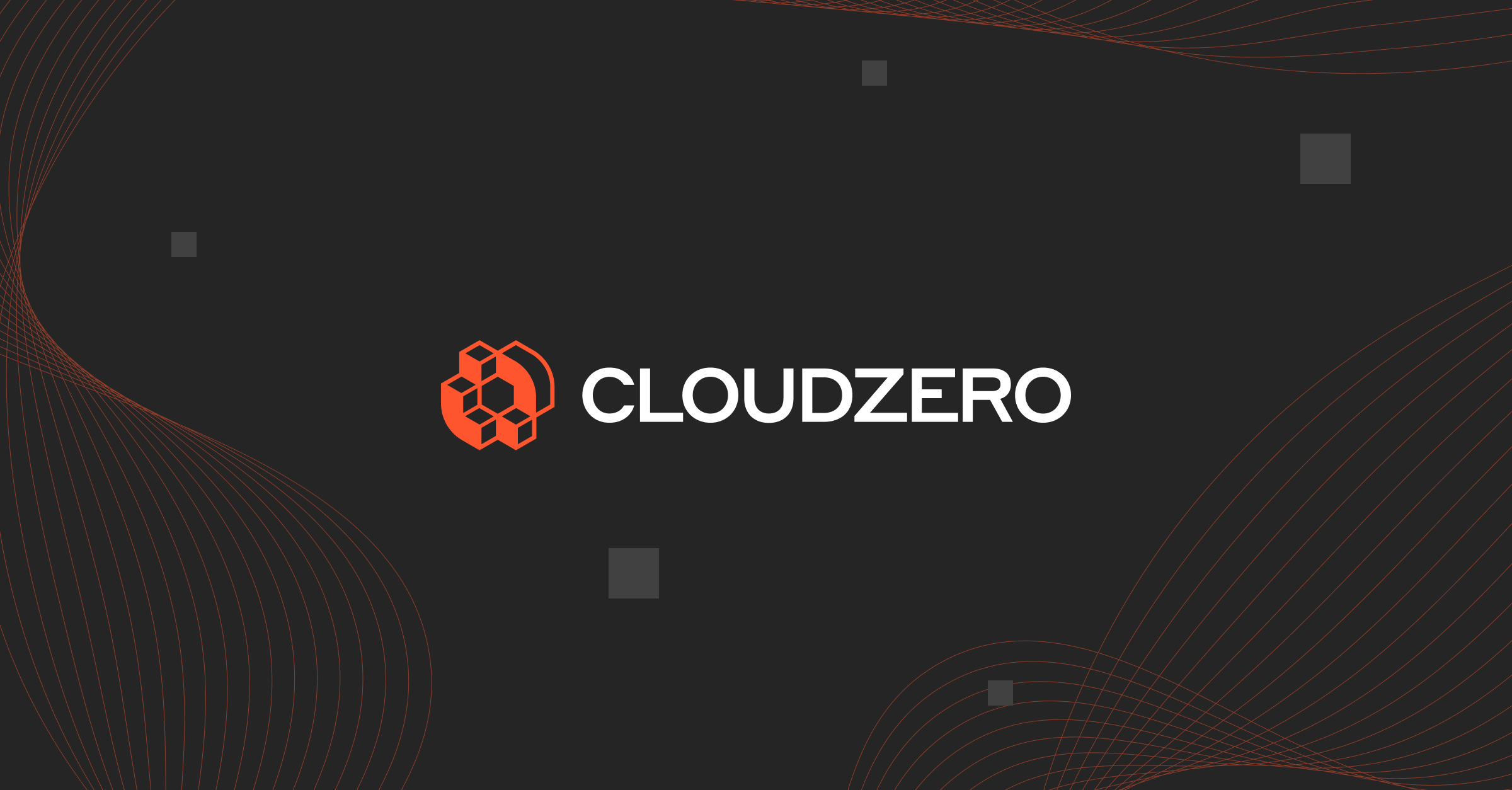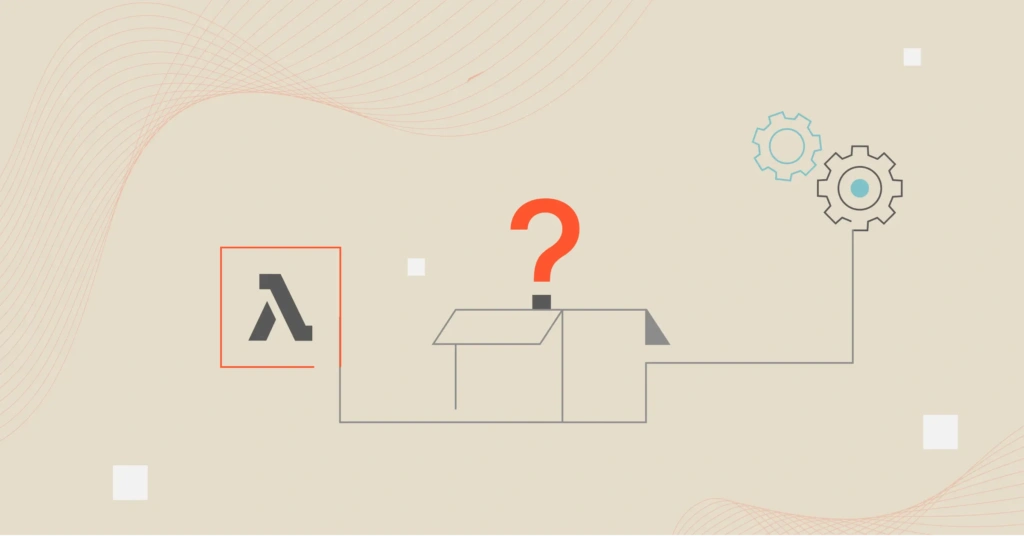Managing modern, complex IT systems manually is like navigating a vast, ever-changing city without a map, GPS, or road signs.
Imagine driving blindfolded, relying solely on occasional radio updates (logs) about traffic jams (issues) and detours (system changes). Not only does this method slow you down, but by the time you react to a traffic jam, it’s already caused gridlock across the city.
Worse, competitors zipping through the city with autonomous cars (AIOps) are faster and more efficient. They avoid the traffic jams entirely while you’re stuck troubleshooting.
This “blindfolded driving” analogy highlights how manual approaches are unsustainable and uncompetitive in today’s high-stakes IT management. Modern IT infrastructures are simply too vast, interconnected, and dynamic to handle without intelligent automation, which is what AIOps tools help with.
What Is AIOps?
AIOps, short for Artificial Intelligence for IT Operations, combines AI and machine learning to help manage and optimize IT operations. It’s an approach designed to address the complexity of managing cloud-based and hybrid infrastructures, where vast amounts of data are generated every second from logs, metrics, and alerts.
By leveraging machine learning and big-data analytics, AIOps can detect patterns, automate responses, and support proactive problem-solving. But that’s not the whole story.
What Does An AIOps Platform Do?
The complexity of cloud computing, microservices, and DevOps practices have made it impossible to manage IT infrastructure manually. AIOps enables IT teams to predict potential issues before they impact services, automate mundane tasks, and correlate events across systems.
The result is it helps reduce downtime and streamline operations. It also improves cost efficiency, optimizing resource usage in real-time (via auto-scaling, for example) and reducing the need for extensive manual monitoring.
What are the key functions of an AIOps tool today?
Data collection and aggregation
This involves gathering and combining data from numerous sources into one centralized system, including logs, metrics, events, and more. AIOps platforms use AI to filter, correlate, and normalize the data for actionable insights at any stage of your DevOps lifecycle.
Instead of tedious data wrangling, your teams can focus on solving actual problems rather than playing detective across disconnected systems.
Noise reduction
It’s tough to pinpoint a priority issue when you have false alarms going off all over the place. With AIOps, you can sift through this chaos by correlating related alerts, suppressing redundant alarms, and avoiding noise fatigue across your team.
Anomaly detection
AIOps helps you compare historical data and real-time indicators. It detects and identifies patterns, flagging potential issues, such as cost anomalies, before they escalate into major user experience problems (or, worse, downtime).
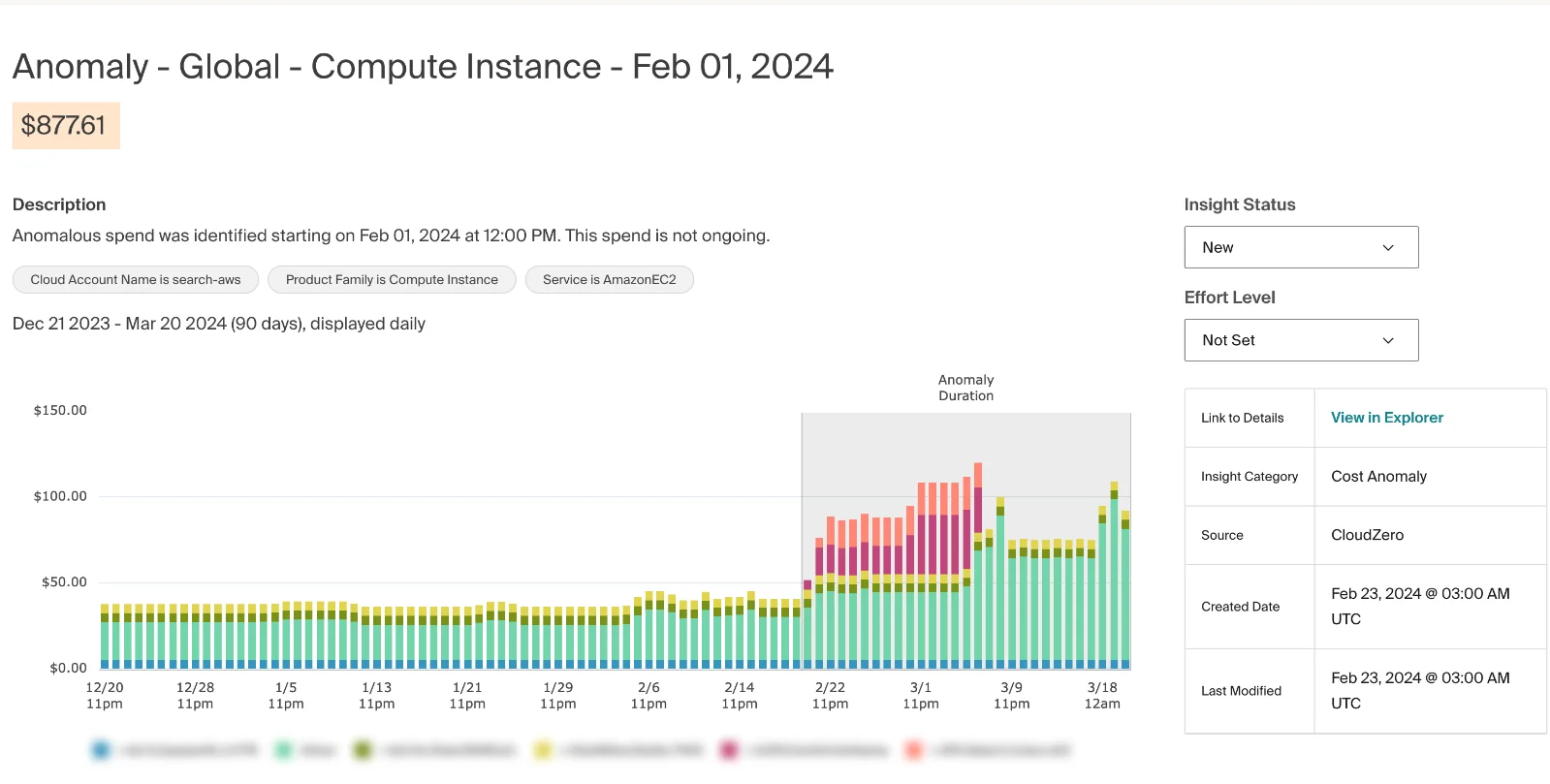
CloudZero cost anomaly detection example
Predictive analysis
By tapping Machine Learning and AI, the tech helps you stay ahead of IT operations challenges. For example, it can detect, compare, and report imbalanced loads across different servers at certain times of the day, helping you swing to action to prevent performance bottlenecks before they happen.
Root Cause Analysis (RCA)
Another significant advantage of AIOps is that it helps you rapidly wade through massive datasets to find the probable cause of an issue. This is crucial for detecting and resolving issues as quickly as possible to avoid hurting user or customer experiences.
Monitoring at scale
While traditional monitoring methods struggle with large volumes of data, AI-powered solutions can handle massive datasets and multiple incidents simultaneously. This scalable observability is crucial for organizations with increasingly complex IT environments (such as hybrid and multi-cloud deployments).
Automated incident response
Over time, you can also hand off repetitive tasks that don’t require human intervention to AI and machine learning assistants. This frees up your human intelligence for more critical and creative tasks.
What Are The Key Benefits Of An AIOps Tool?
Using the right AIOps platform for your needs can have the following tangible benefits:
- Improve efficiency, such as reducing manual work by automating repetitive tasks. Want to find out how your cloud spending compares to your peers? Try it out with this handy cost benchmarking tool.
- Increase visibility in IT operations by aggregating, analyzing, and reporting data from different systems in a single source of truth.
- Resolve problems faster through anomaly detection, root cause analysis, and automatic incident response.
- Ensure proactive management by constantly learning, identifying potential issues, and notifying the right team members in time.
- Reduce IT operations costs using auto-scaling and anomaly detection to prevent waste.
Earlier, we attempted to navigate a busy city without GPS. A paper map might give you the layout, but it can’t provide real-time updates, identify optimal routes, or alert you to hazards ahead.
You’d be constantly stopping, recalculating, and making decisions that might already be outdated.
Now, consider GPS as AIOps. It uses real-time data, identifies patterns like traffic jams (system bottlenecks), suggests alternative routes (automated solutions), and even predicts your arrival time (capacity planning).
Without it, you’d struggle to reach your destination efficiently. You’d also risk being outpaced by those using smarter tools — leaving you uncompetitive (and likely struggling to retain customers and employees).
Now that you see what AIOps can do for your organization, you might wonder where to begin.
The Best AIOps Tools For Every Engineering Function
If you have very particular requirements, you can build a complete AIOps platform from the ground up. But in most cases, you can use a SaaS AIOps tool where someone else securely does the building, updating, and continuous innovation on your behalf.
In that case, here are some of the best AIOps services you can use right away for various use cases.
1. CloudZero
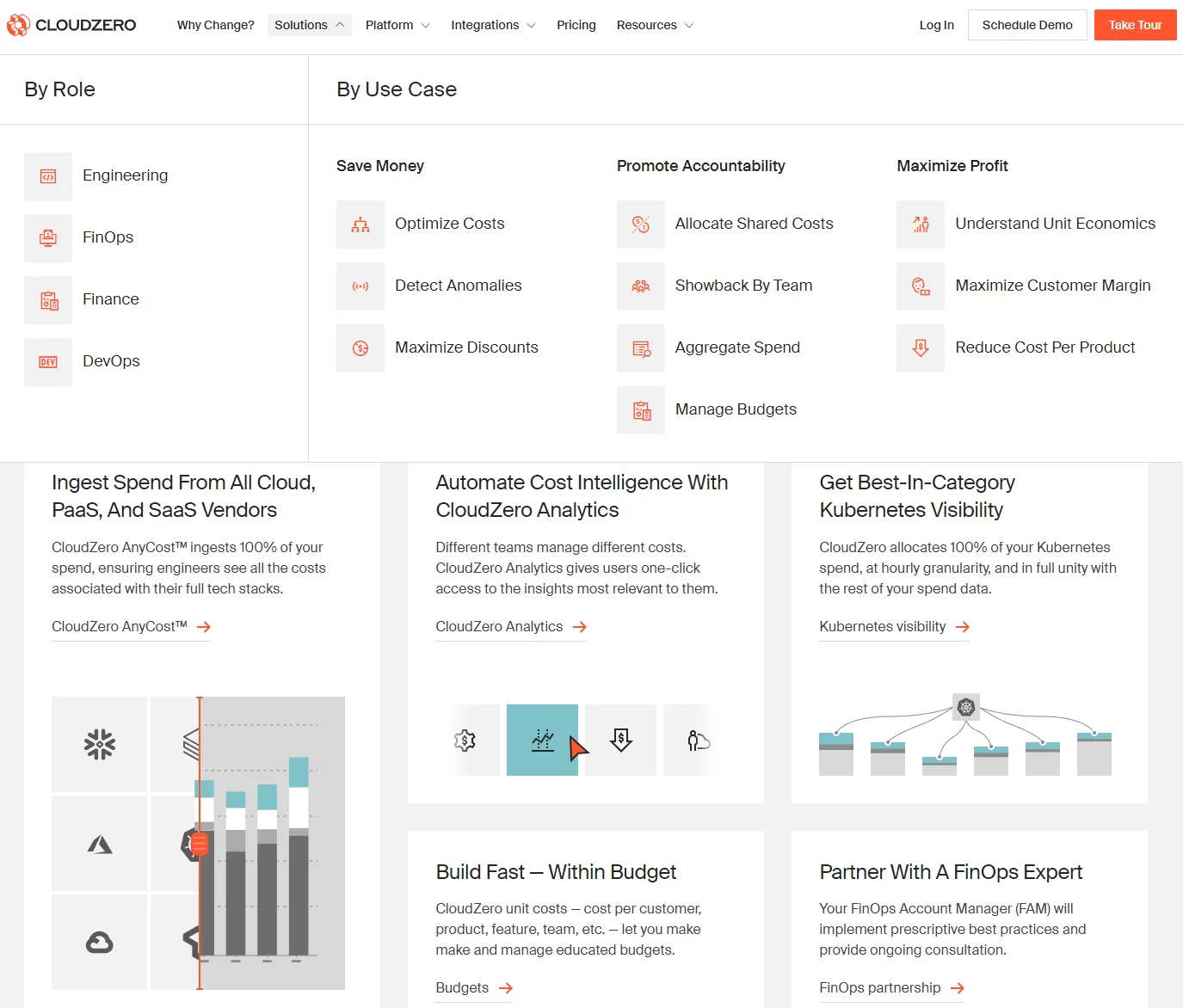
By ingesting, allocating, and analyzing cost data at scale, CloudZero is more like an observability platform than a traditional cloud cost tool. CloudZero also stands out for blending engineering empowerment (Engineering-Led Optimization) with granular cost insights (unit cost economics).
It uses a telemetry-driven approach to allocate 100% of cloud costs with high precision. This approach maps all costs to the people, products, and processes that generate them, enabling you to conduct root cause analyses on your costs. That’s nowhere near all.
With CloudZero’s AI/ML solutions, you can:
- Get spend data from anywhere, from AWS to Kubernetes to New Relic, and visualize it under a single pane of glass with zoom in/out options.
- Drive Engineering-Led Optimization, which gives your engineers granular cost insights, with or without perfect cost allocation tags, so they can take proactive ownership of their cloud spending.
- Get real-time insights including Cost per Feature, Cost per Environment, and Cost per Request. This way, your IT teams can course-correct quickly and develop more cost-efficient solutions as they develop them.
- Track detailed unit economics, such as Cost per Customer, to identify profitable segments (target them more for higher ROI), set fair yet profitable SaaS pricing, and improve your Cloud Efficiency Rate.
- Leverage CloudZero’s real-time anomaly detection for timely, noise-free, context-rich alerts to prevent surprise costs.
With CloudZero, ambitious brands, from New Relic to Drift to MalwareBytes, have reduced their annual cloud spend by millions. Drift has saved over $3 million while Uptly just saved $20 million, as examples.
Reading about CloudZero’s capabilities is nothing like seeing it in action for yourself. And yes, it’s risk-free to try out CloudZero.  to experience it firsthand.
to experience it firsthand.
2. Dynatrace – Comprehensive platform with infrastructure monitoring, advanced analytics, and security support
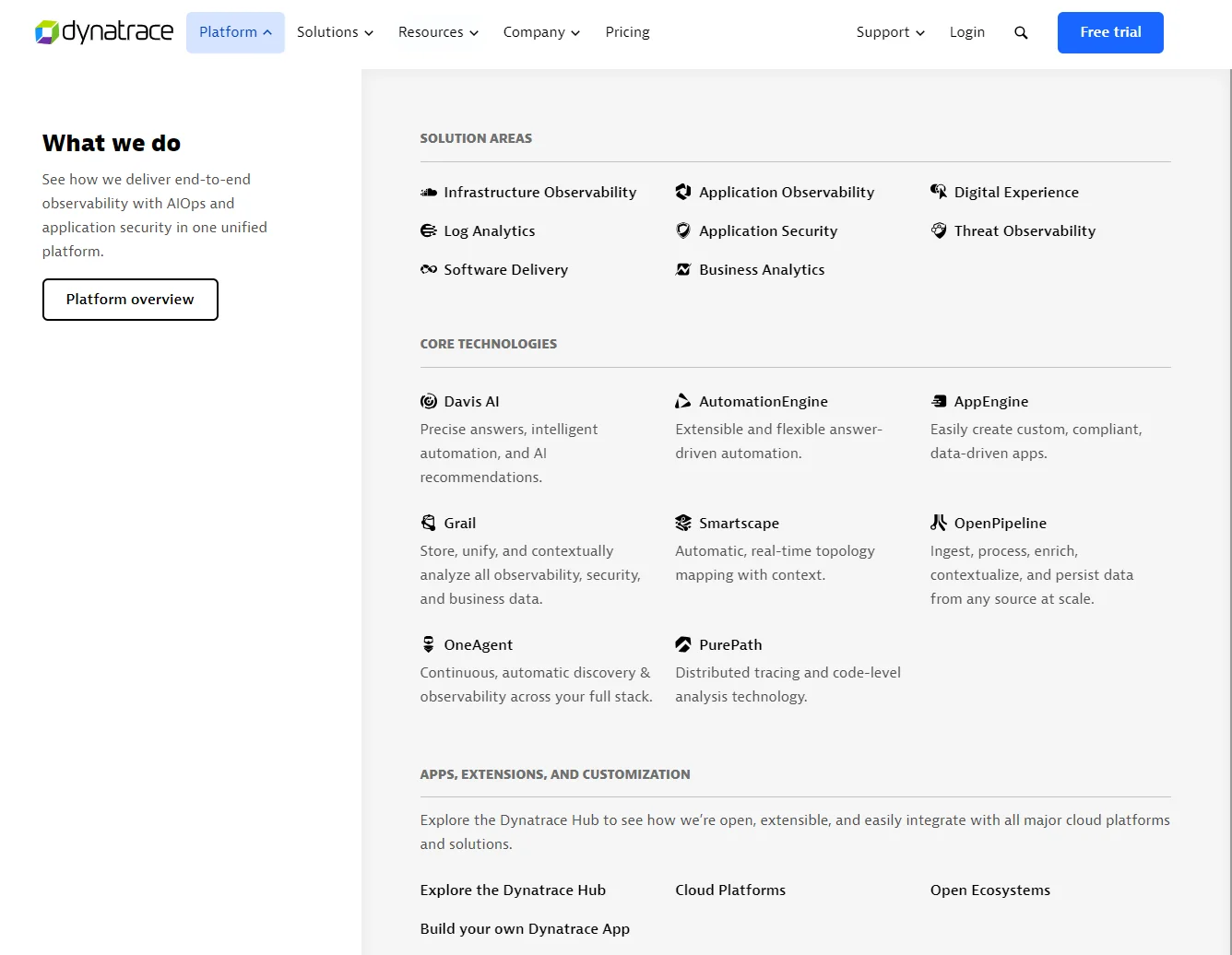
Dynatrace is one of the leading observability platforms we’ve highlighted on the CloudZero blog before. A standout feature here is its Davis AI engine. The AIOps tool combines predictive, causal, and generative AI to deliver precise insights and automate root cause analysis.
Unlike traditional tools that often require manual configuration, Dynatrace offers automatic dependency discovery and real-time visibility across hybrid and multi-cloud environments. This ensures your IT operations team can identify issues swiftly and accurately – reducing downtime and improving the user experience.
Additionally, Dynatrace integrates seamlessly with most existing workflows. This helps automate repetitive tasks efficiently and frees up your IT staff to focus on innovation rather than firefighting.
Dynatrace is best for organizations that need enterprise-level AIOps for IT operations in dynamic cloud environments or traditional setups.
The Dynatrace pricing model supports scalability with hourly pricing for features like full-stack monitoring and application security.
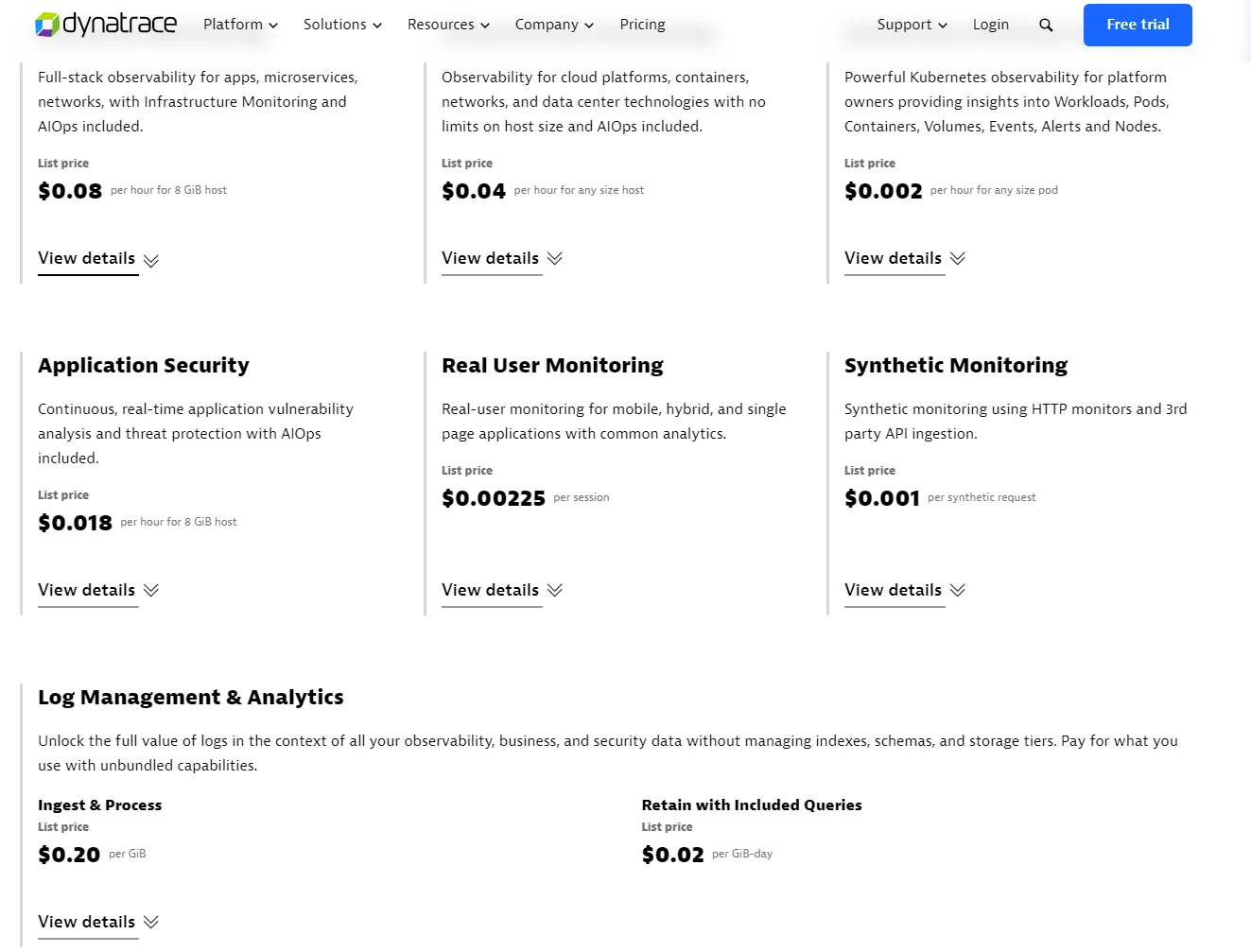
3. Datadog – Cloud-based monitoring platform with strong AI/ML capabilities
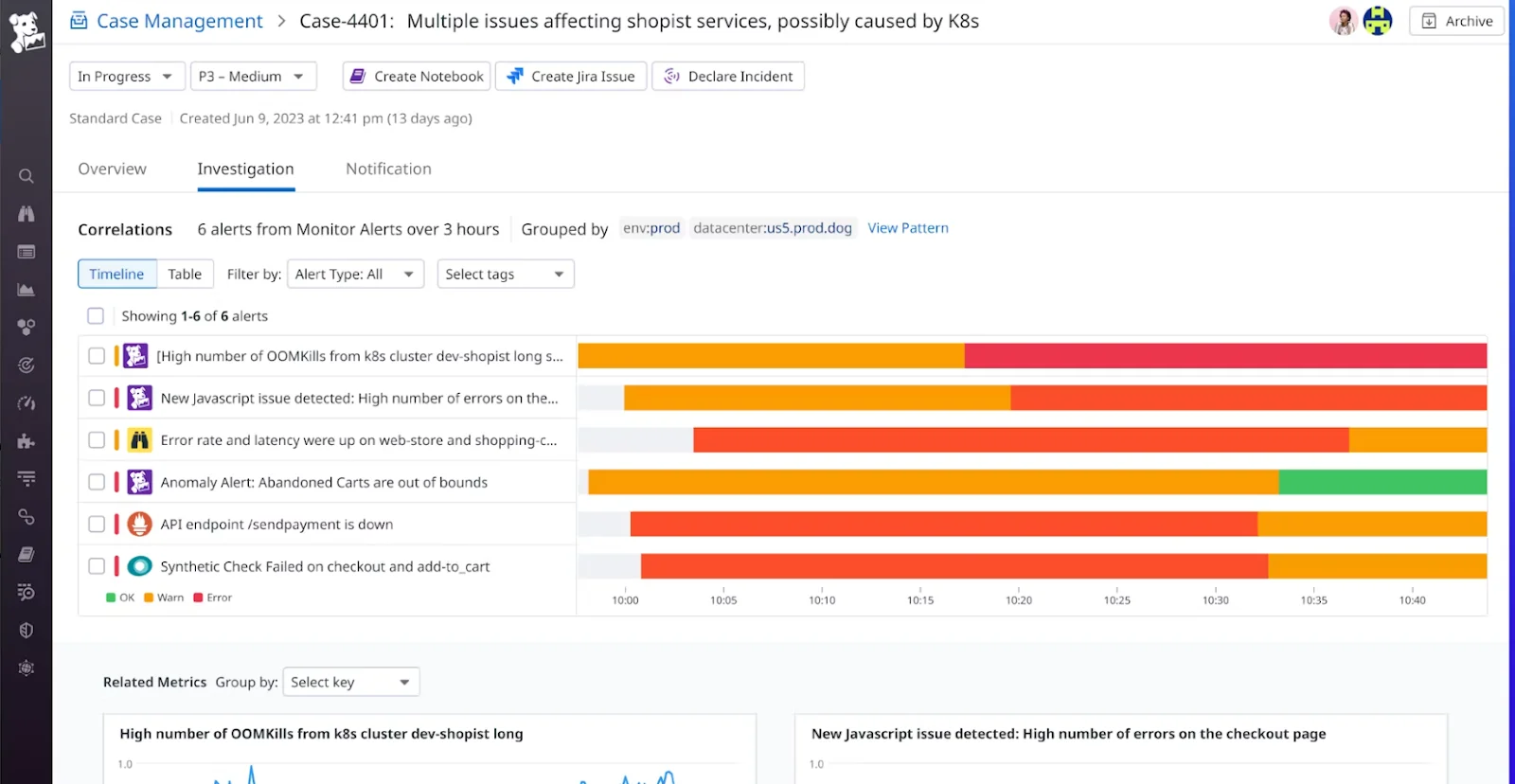
Watchdog is the core of Datadog’s AIOps platform. The tool combines the platform’s well-known observability capabilities across metrics, logs, and traces. This approach allows for automated root cause analysis and real-time anomaly detection without additional setup.
By correlating alerts from multiple sources intelligently, Watchdog reduces noise and enables IT teams to focus on critical issues. In addition, it continuously learns from data patterns, improving its ability to predict and resolve incidents quickly.
Datadog is best for enterprise-grade, multi-cloud IT operations, thanks to its comprehensive monitoring and advanced AI capabilities.
The Datadog pricing model uses a flexible, modular pricing structure that charges based on factors like the number of hosts monitored, data ingested, log retention periods, and the features you use (e.g., APM, custom metrics, and synthetic monitoring).
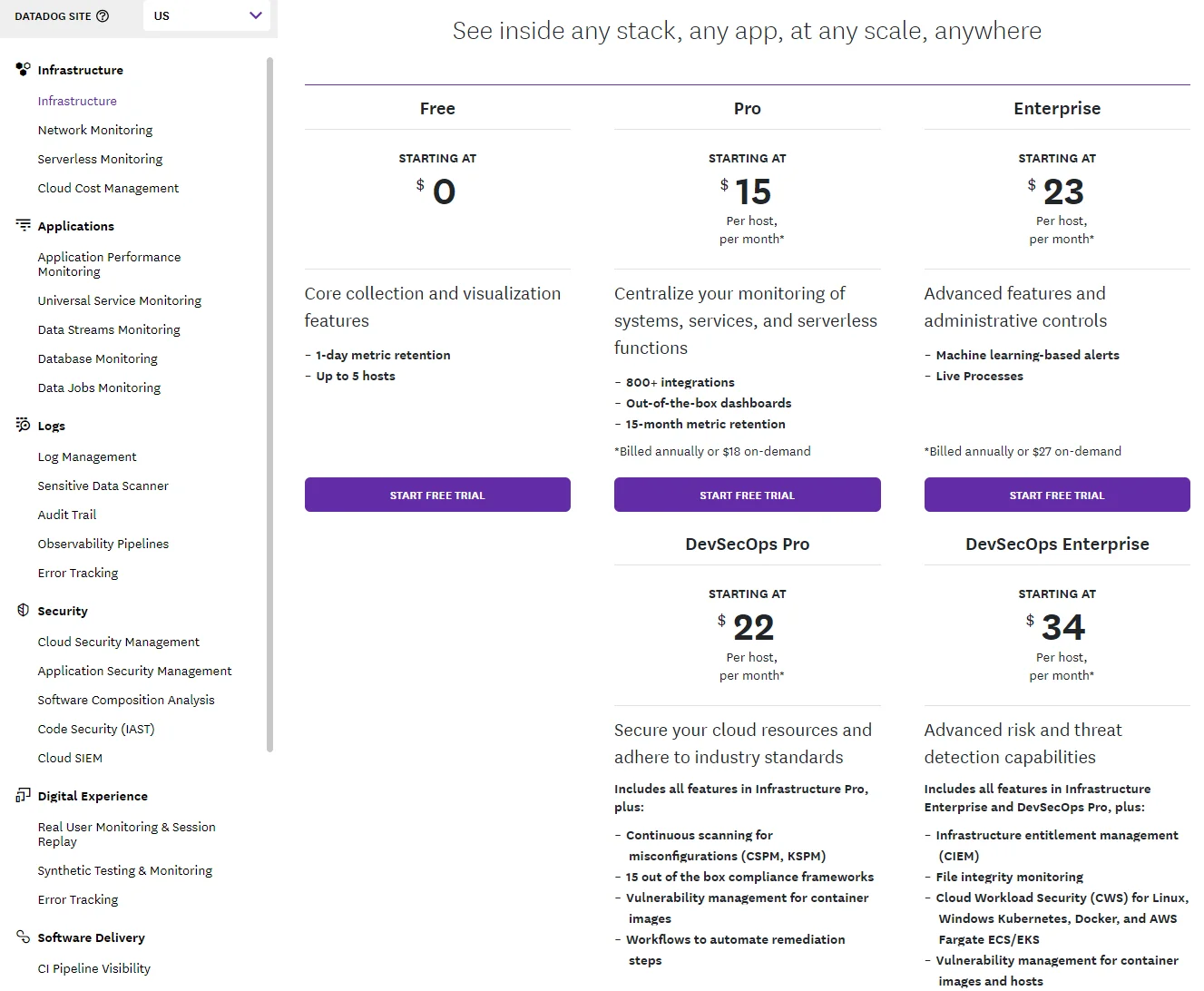
Organizations can also choose between hourly, monthly, or annual commitments, with discounts available for prepaid and committed usage plans — adaptable to varying needs and budgets.
4. AppDynamics – Real-time insights into application performance and user experience
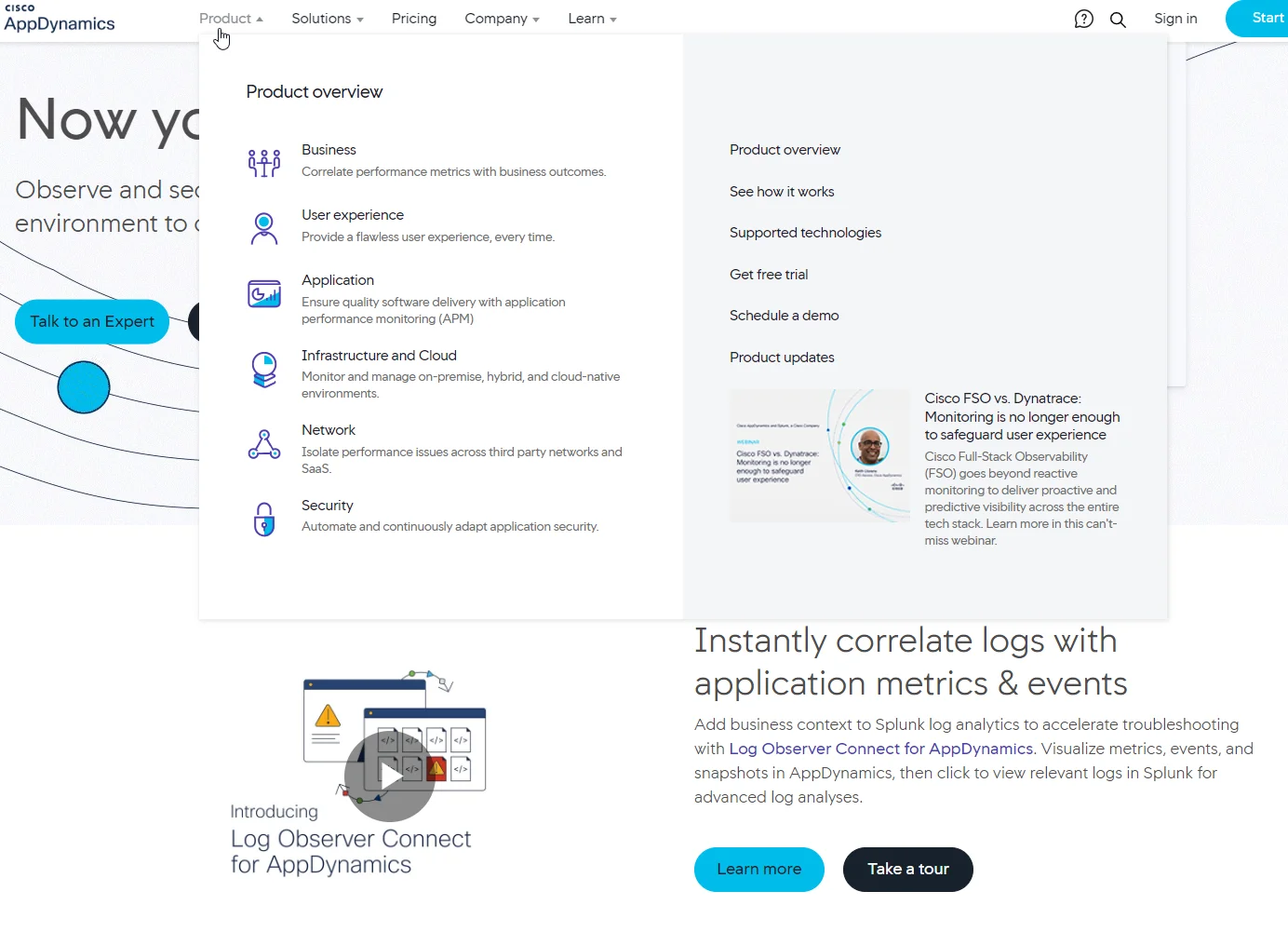
Under Cisco AIOps, AppDynamics betters IT operations by tightly integrating advanced automation with its Application Performance Management (APM) capabilities (it’s best known for this). Expect real-time app monitoring and automated root cause analysis, enabling your people to detect anomalies and resolve issues before they escalate to unsubscriptions.
Unlike many alternatives, AppDynamics offers Experience Journey Mapping, visualizing user interactions across applications, providing deeper insights into customer experiences.
AppDynamics is best for organizations aiming to optimize application performance and ensure seamless user experiences at scale.
AppDynamics pricing works on a subscription-based model tailored to specific monitoring needs. It starts from foundational tools at around $6 per CPU core per month. Then it scales up to more advanced enterprise editions at $167 per core per month for SAP monitoring.
You can also get specialized pricing based on features like infrastructure, real-user monitoring, and business performance analytics (with a free trial available for new users to test the platform).
5. New Relic – Combines AIOps with observability features
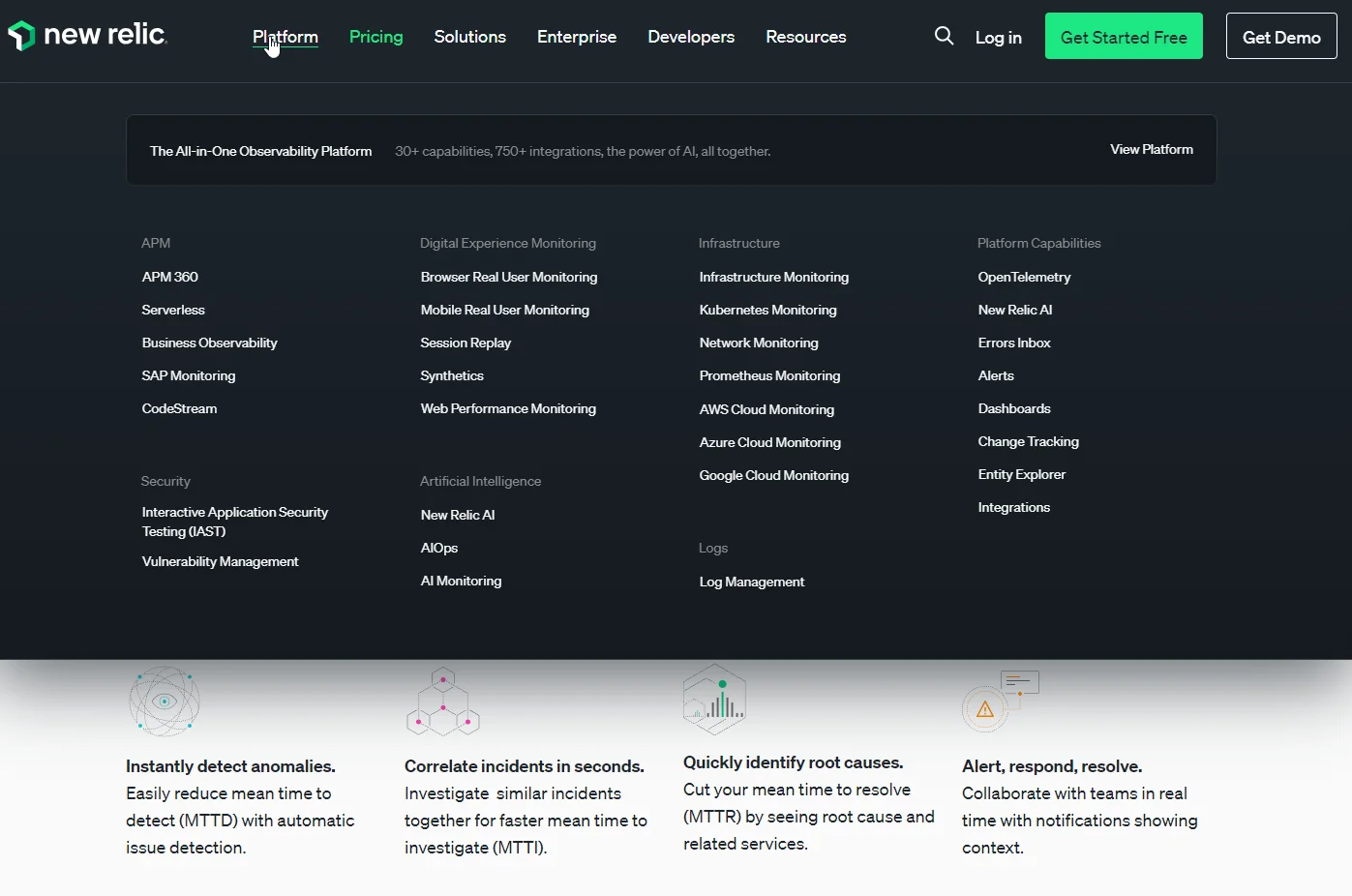
New Relic AIOps has unique integration with the NRDB, a unified telemetry database that powers machine learning models. This enables intelligent incident correlation and context-rich alerts, an excellent way to reduce alert noise.
Unlike many alternatives, New Relic AIOps helps you automate the identification of alert coverage gaps and suggests new alerts based on anomalous behavior. This ensures it is accessible even for less experienced engineers.
New Relic is best for medium and large enterprises seeking seamless integration across various data sources to capture and respond to incidents faster.
New Relic pricing is usage-based and primarily charges for the amount of data ingested and the number of billable users with access to its features.
Customers start with 100 GB of free monthly data ingestion and one free full-platform user. Beyond that, data ingestion costs $0.30–$0.50 per GB, depending on the plan. Additional user fees vary by role, such as Core ($49/user) or Full Platform ($99/user) users.
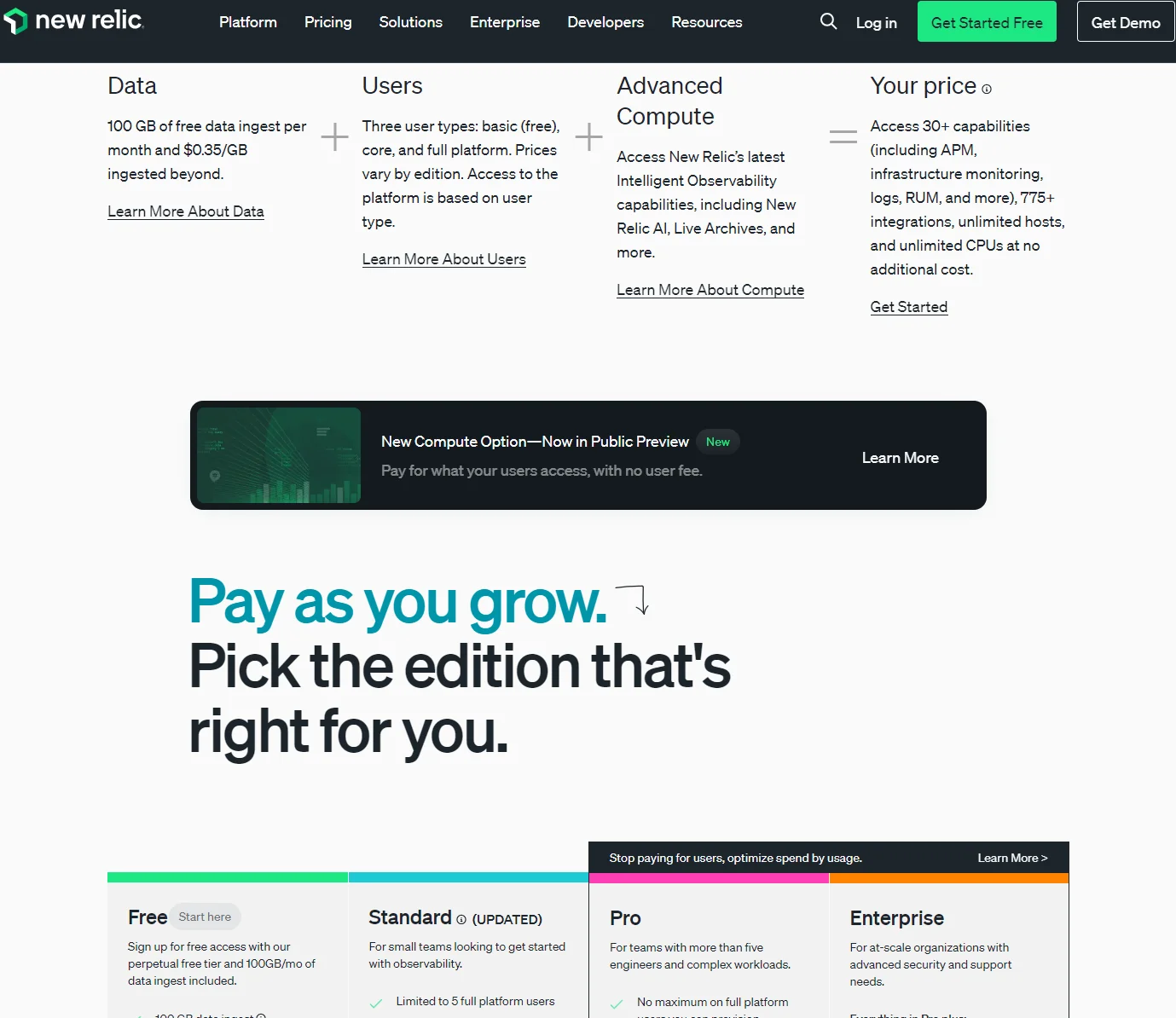
6. BigPanda – Focuses on event correlation and incident management
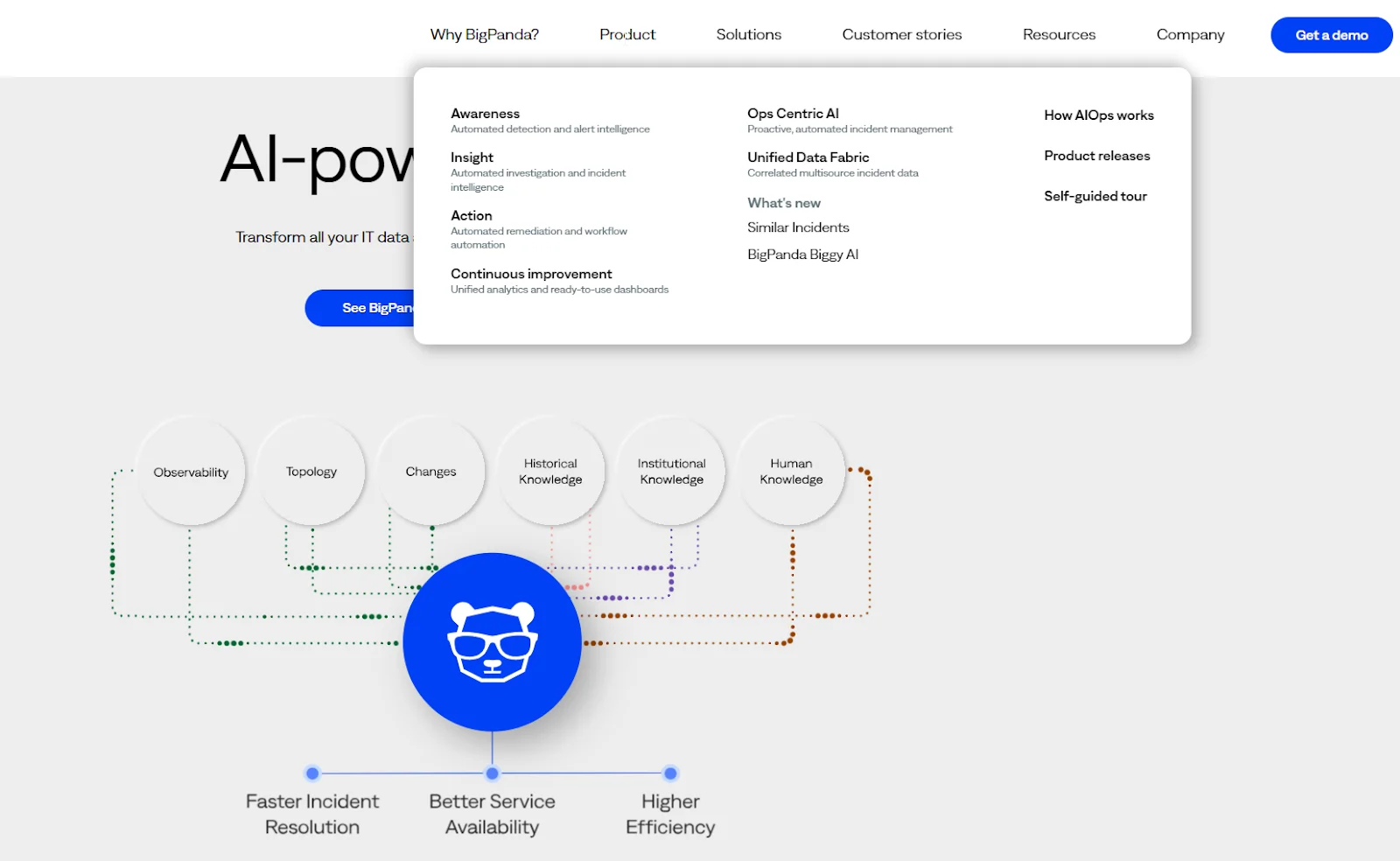
BigPanda’s advanced event correlation capabilities automatically sift through alerts from various monitoring tools. It promises to reduce noise by up to 95% to help your IT operations team beat overwhelm by irrelevant alerts. Also, BigPanda employs machine learning for root cause analysis and automated incident resolution workflows.
Its “Open Box AI” approach ensures transparency and control over AI processes, improving user trust.
BigPanda is best for organizations wanting to significantly shorten mean time to resolution (MTTR) compared to traditional AIOps solutions.
BigPanda pricing is typically customized (you get a quote). However, its costs are designed to reflect the complexity and scale of your IT environment. The pricing may also consider integrations with existing tools and your specific needs, such as tool consolidation or incident management volume.
7. PagerDuty – Specializes in incident management and alert filtering
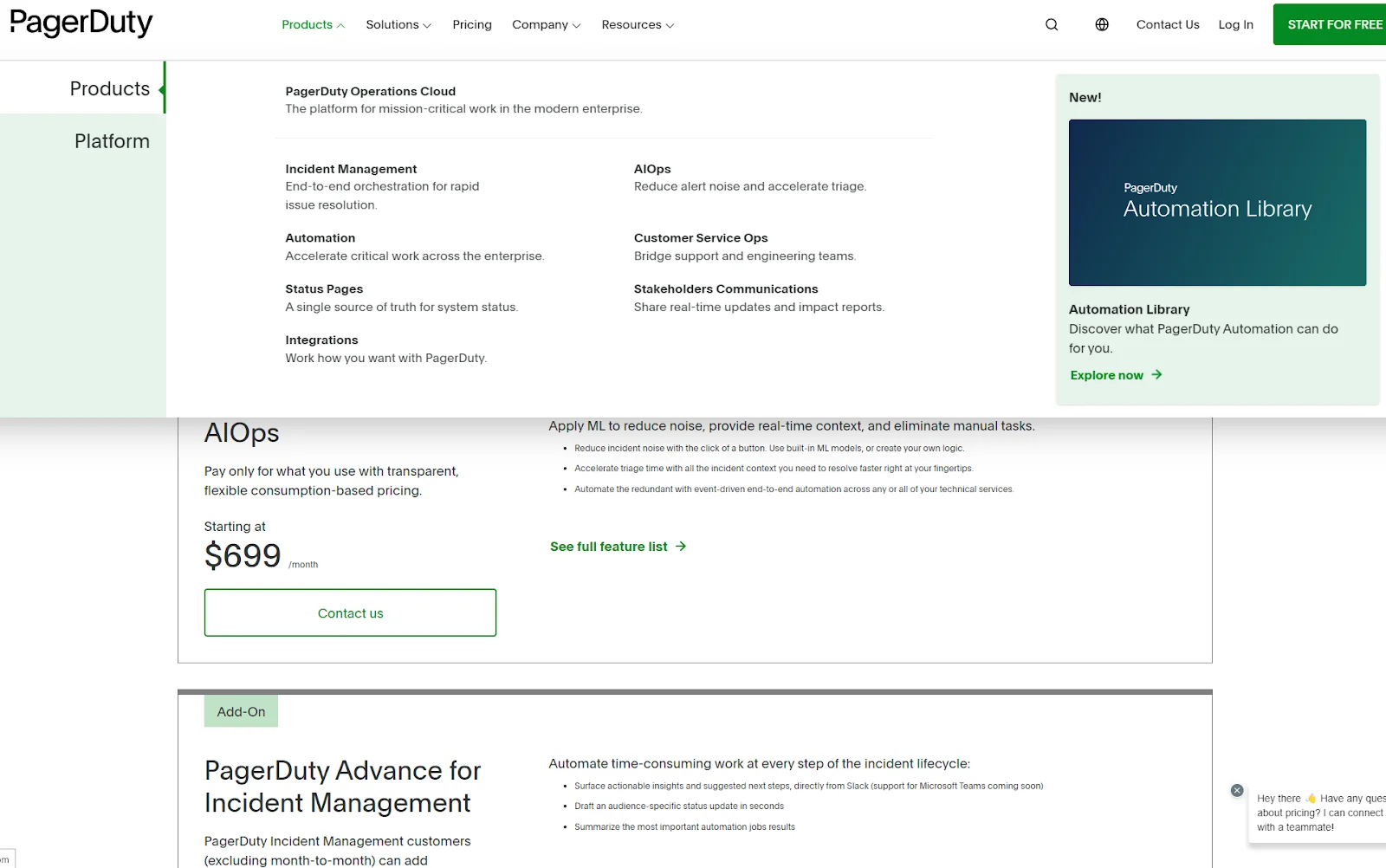
PagerDuty’s incidence management platform offers end-to-end automation without the lengthy setup typical of other platforms. Its unique ability to leverage existing incident management data allows it to deliver actionable insights and valid recommendations in just days rather than weeks.
They promise an impressive 87% reduction in alert noise — great for enabling your IT ops to focus on critical tasks instead of drowning in alerts. And, with over 700 integrations, PagerDuty seamlessly fits into existing workflows. It is a versatile choice for IT and development teams looking to improve operational responsiveness.
PagerDuty is best for enterprise-grade incident management at the speed of the Internet.
PagerDuty pricing is subscription-based, billed per user per month, with several tiers offering varying features.
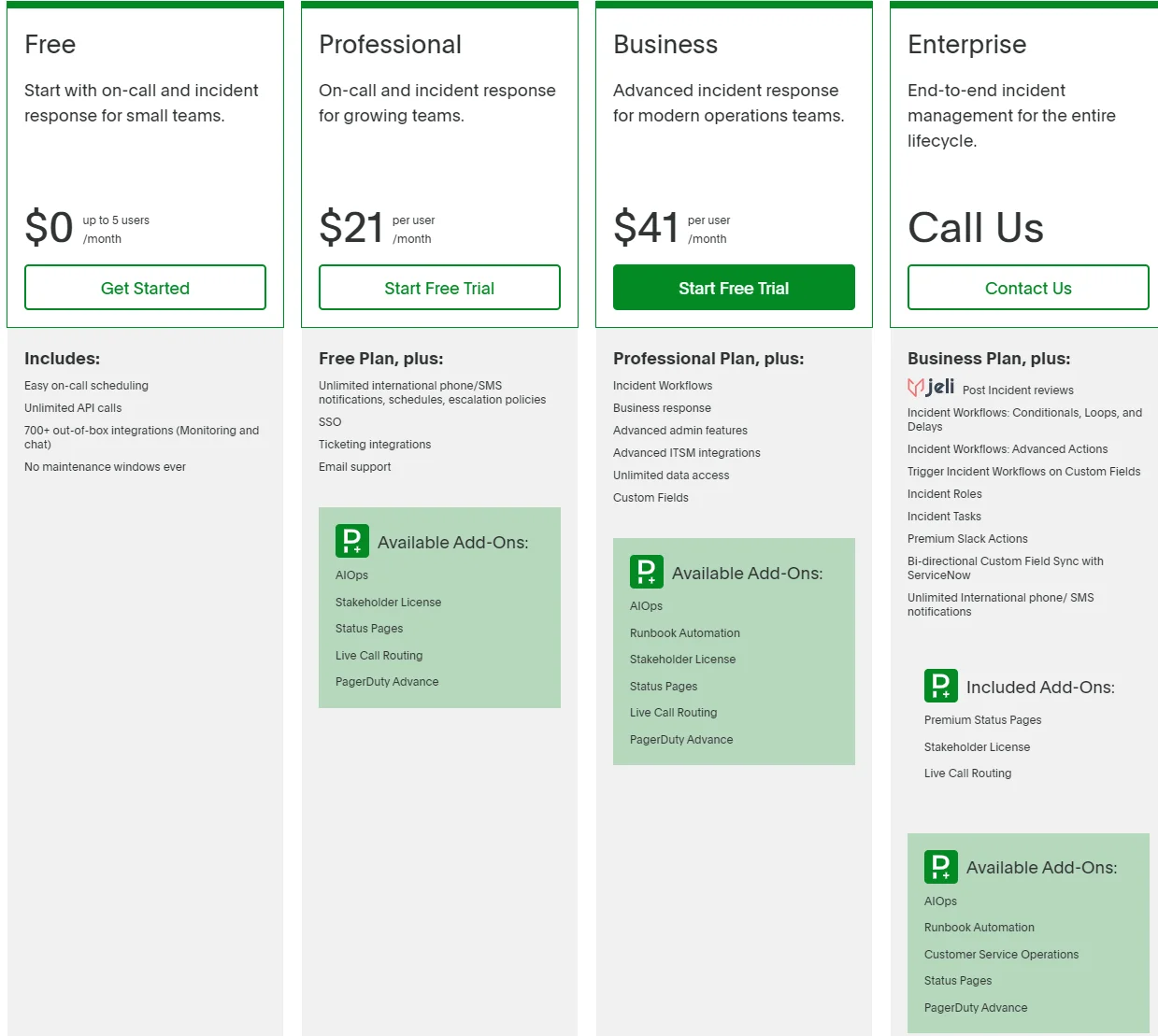
There is a free plan for up to 5 users with basic on-call and alerting tools. Premium plans like Professional ($19/user/month), Business ($39/user/month), and Digital Operations (custom pricing) include more advanced features such as real-time triaging, advanced analytics, and unlimited notifications. Plans can be billed monthly or annually.
8. Splunk – IT Service Intelligence
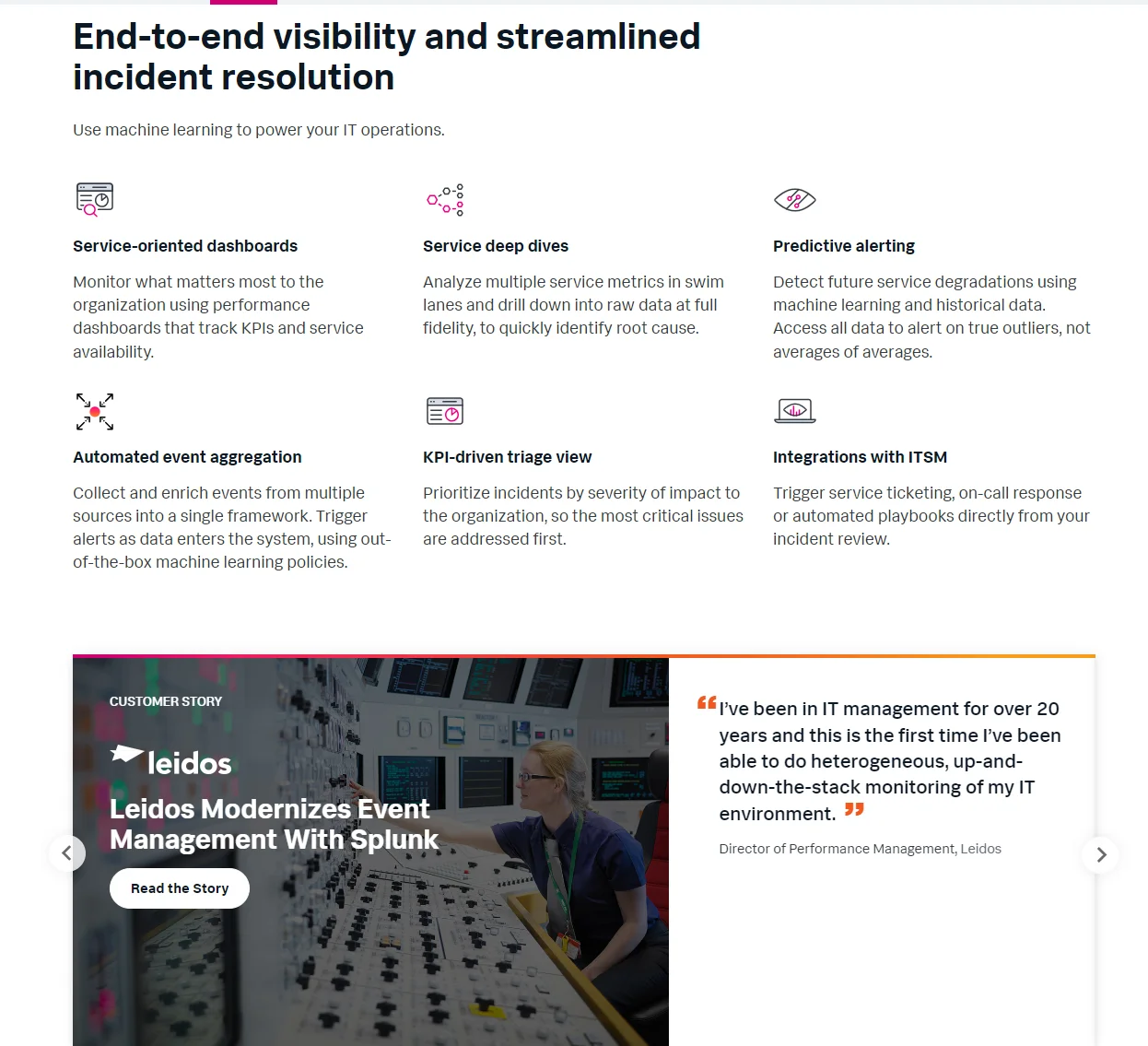
Another observability platform by Cisco (and now a stablemate with AppDynamics). Splunk AIOps integrates real-time data analysis, machine learning, and automated incident response into a single platform. Its intelligent dashboards prioritize incidents based on their impact, streamlining workflows and improving team collaboration. Additionally, Splunk’s predictive analytics capabilities help you address potential issues before they affect users.
Splunk is best for dynamic environments that need to anticipate, catch, and report potential IT operations issues at scale.
Splunk pricing works through two primary models: Ingest-based pricing charges based on the volume of data ingested daily (measured in GB/day). Workload-based pricing is tied to compute power usage measured in Splunk Virtual Compute (SVC) units.
9. LogicMonitor – In-depth visibility into IT infrastructure
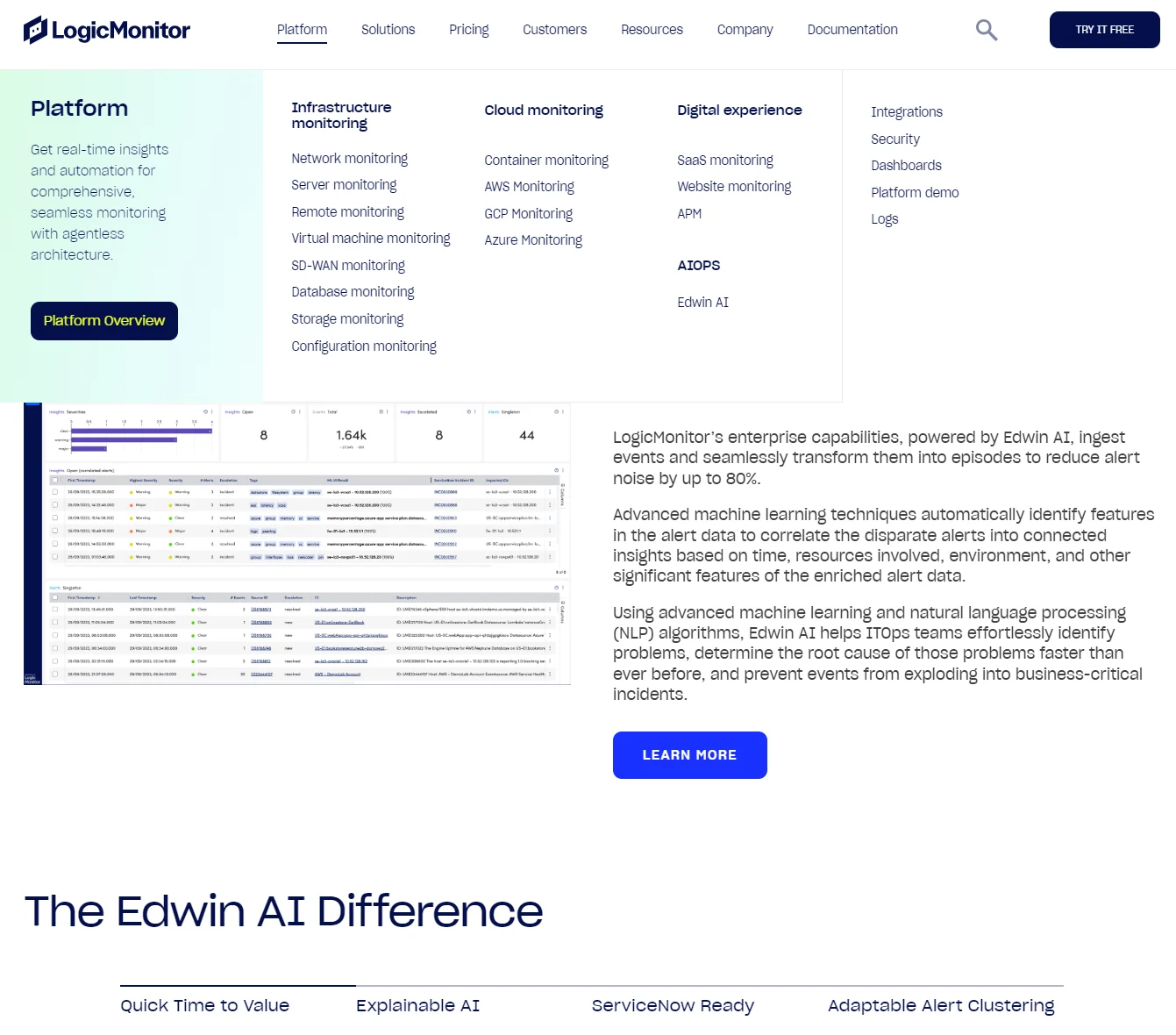
LogicMonitor AIOps tools include agentless collectors and an AIOps Early Warning System. The Edwin AI feature leverages machine learning to predict potential outages by analyzing historical performance data. This combination reduces alert fatigue for modern IT operations.
LogicMonitor is best for organizations that need to automate and improve observability across hybrid and multi-cloud environments.
LogicMonitor pricing is based on a per-device subscription model. You pay for each monitored device rather than individual metrics or data points. This approach includes unlimited metrics per device, making it cost-effective for environments with extensive monitoring needs. However, LogicMonitor encourages you to talk to them directly since pricing can vary depending on the scale and specific features you require.
10. Moogsoft (Dell APEX AIOps) – Cloud AIOps platform for incident resolution
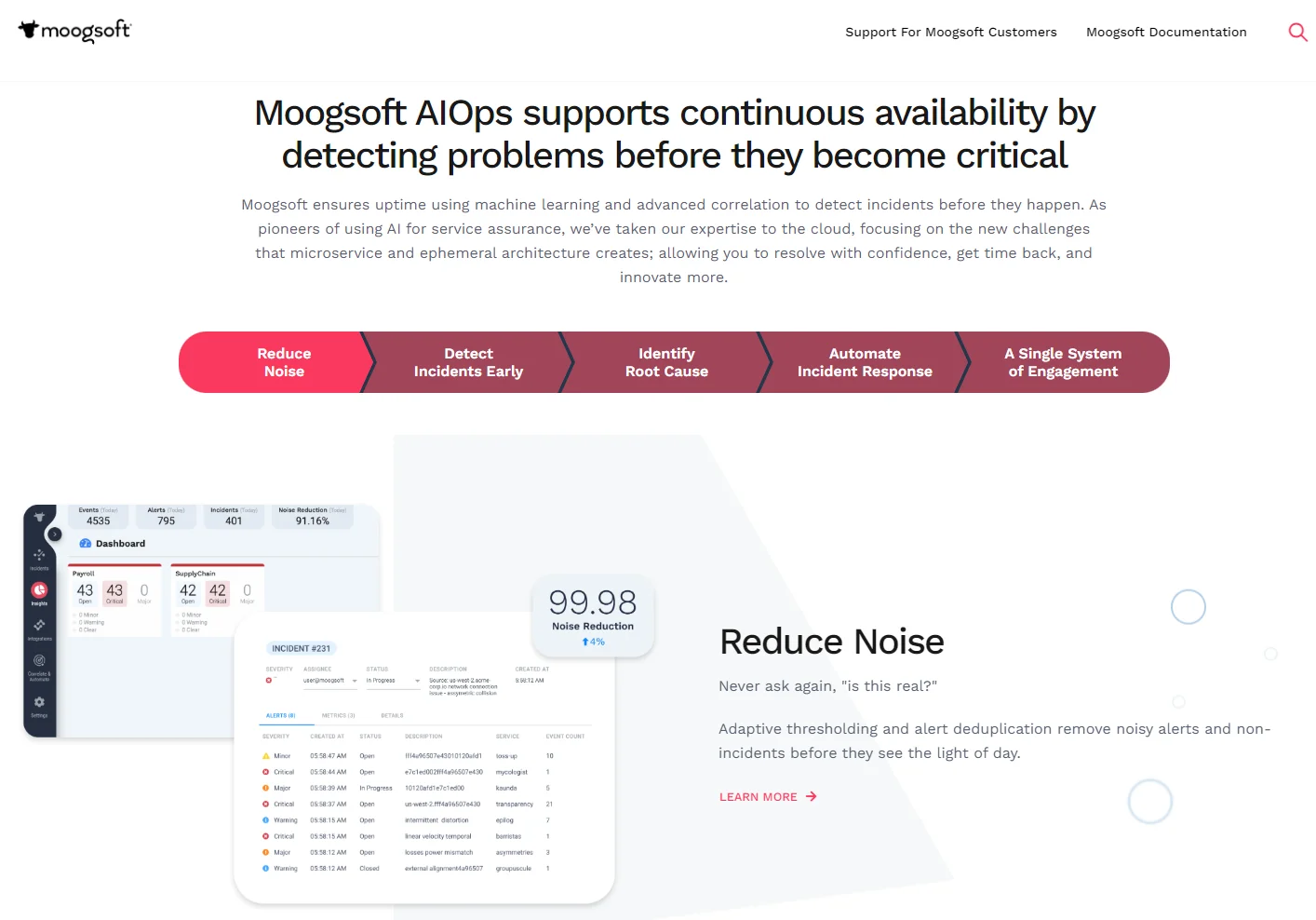
Moogsoft used to be platform-agnostic but is now a part of Dell Technologies. However, it wants to be your all-in-one incident home base under Dell’s APEX AIOps.
Like other AIOps platforms on this list, expect advanced automated incident reporting, root cause analysis, and noise reduction. Unique tools, such as adaptive thresholding, eliminate noise from alerts, ensuring your team can focus on critical issues. It also supports real-time communication among cross-functional teams, easing team-based incident resolution.
Moogsoft is best for dynamic IT operations teams that want a nifty yet powerful AIOps tool for service assurance.
Moogsoft pricing is custom, including a demo.
11. IBM Instana – Full-stack observability platform
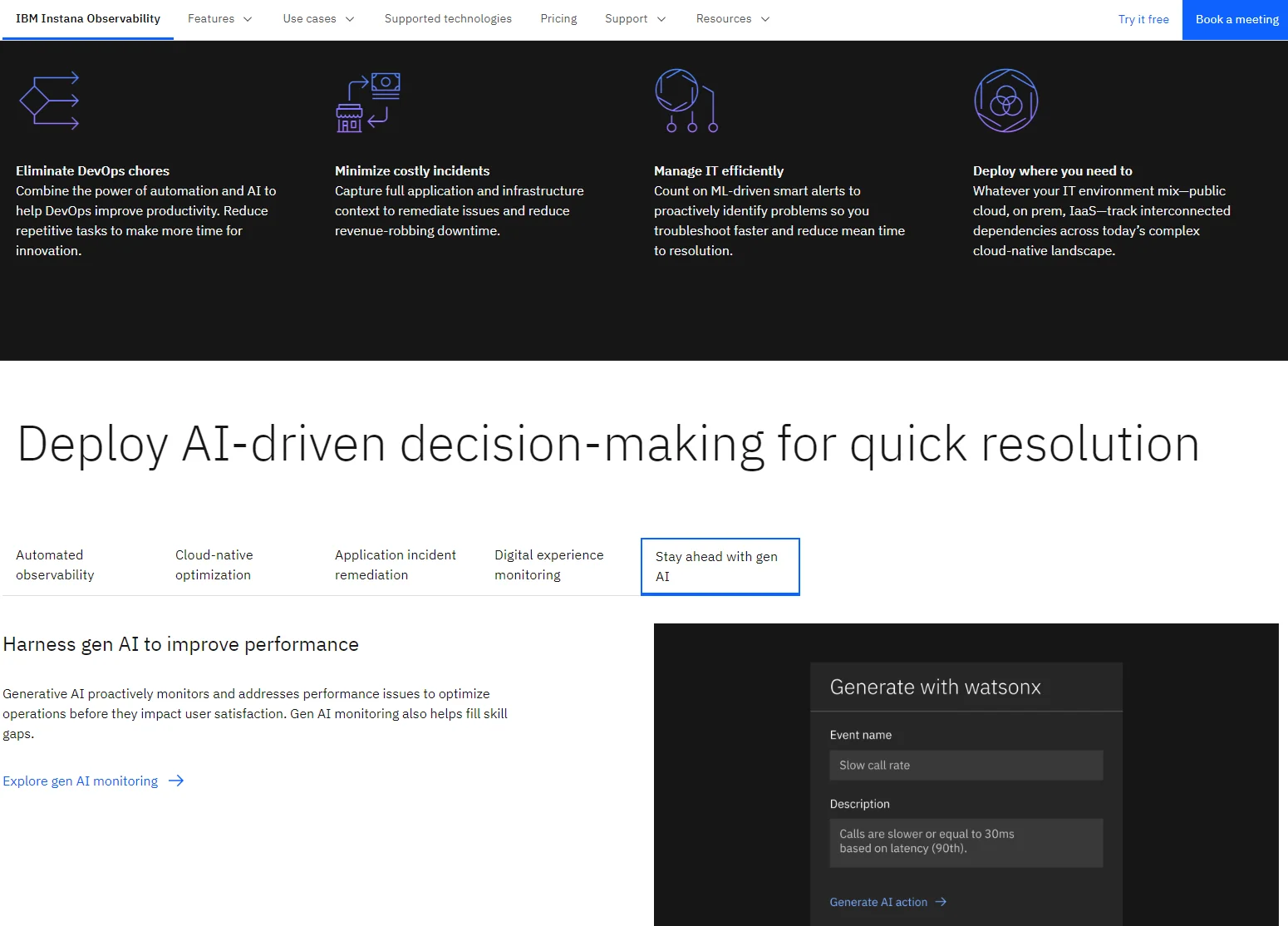
IBM Instana AIOps stands out for its automatic mapping of application dependencies and performance metrics. This helps your team get context-rich insights without sampling or partial traces. This is excellent for enriching root cause analysis with data correlated from various sources, including events and tickets.
Something else. Instana seamlessly integrates with IBM Watson AIOps. This means enriched predictive actions and automated incident remediation, good for reducing your mean time to resolution (MTTR).
IBM Instana is best for enterprises, especially if you have a traditional IT operations setup, hybrid cloud, or multi-cloud infrastructure.
IBM Instana’s pricing is based on a per-host model. You are charged for each physical or virtual host you monitor. This approach includes all features, such as distributed tracing, anomaly detection, and root cause analysis, without additional fees for specific capabilities. It’s designed to scale with your infrastructure – not with the number of users or data volume.
12. ScienceLogic SL1 – System and application monitoring platform
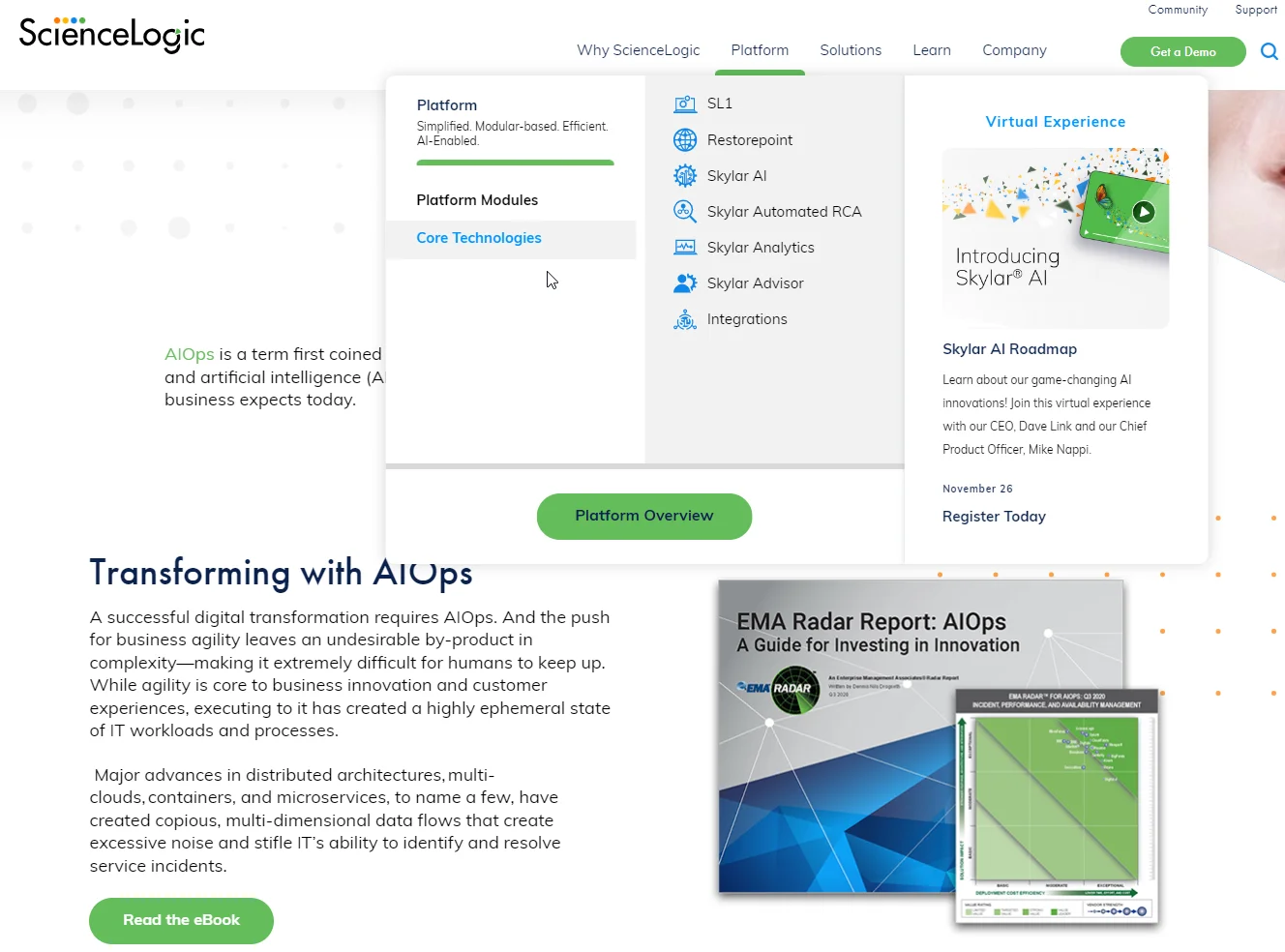
ScienceLogic’s SL1 AIOps platform promises context-infused insights and real-time visibility across hybrid cloud environments. Also, expect automated root cause analysis using machine learning (continuous learning). The platform’s intuitive interface supports personalized operational views and seamless integration with collaboration tools like Slack and WebEx. It is also fast-growing with frequent updates promoting continuous improvement based on user feedback.
ScienceLogic SL1 is best for you if you want a cloud-native AIOps platform with hybrid cloud capabilities – albeit with a less steep learning curve than some tools on this list.
ScienceLogic SL1 uses a custom pricing model based on factors such as deployment type, features included, and the scale of your IT environment.
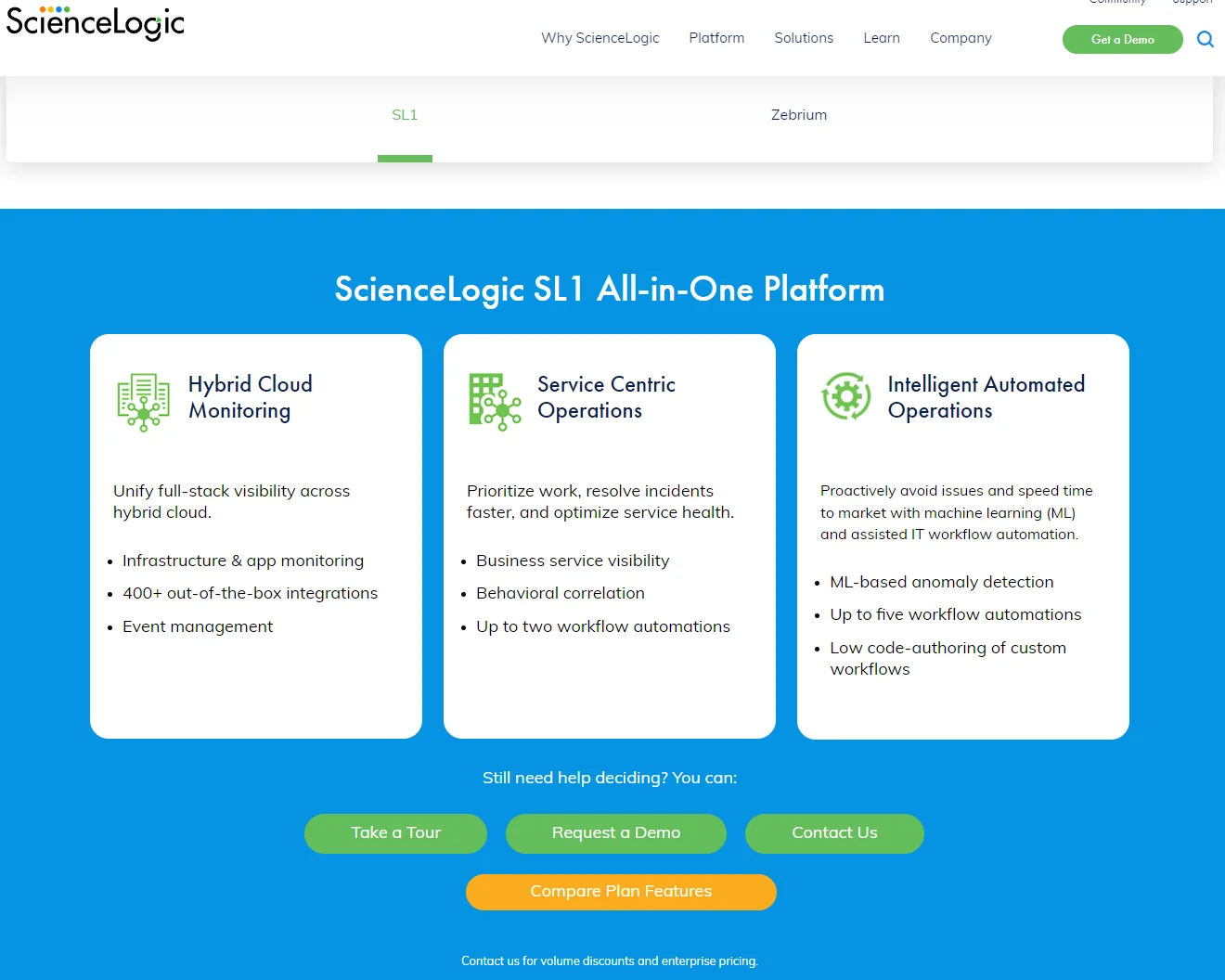
However, precise cost details are typically available upon request.
13. Zenoss Cloud – Comprehensive monitoring service and AIOps platform
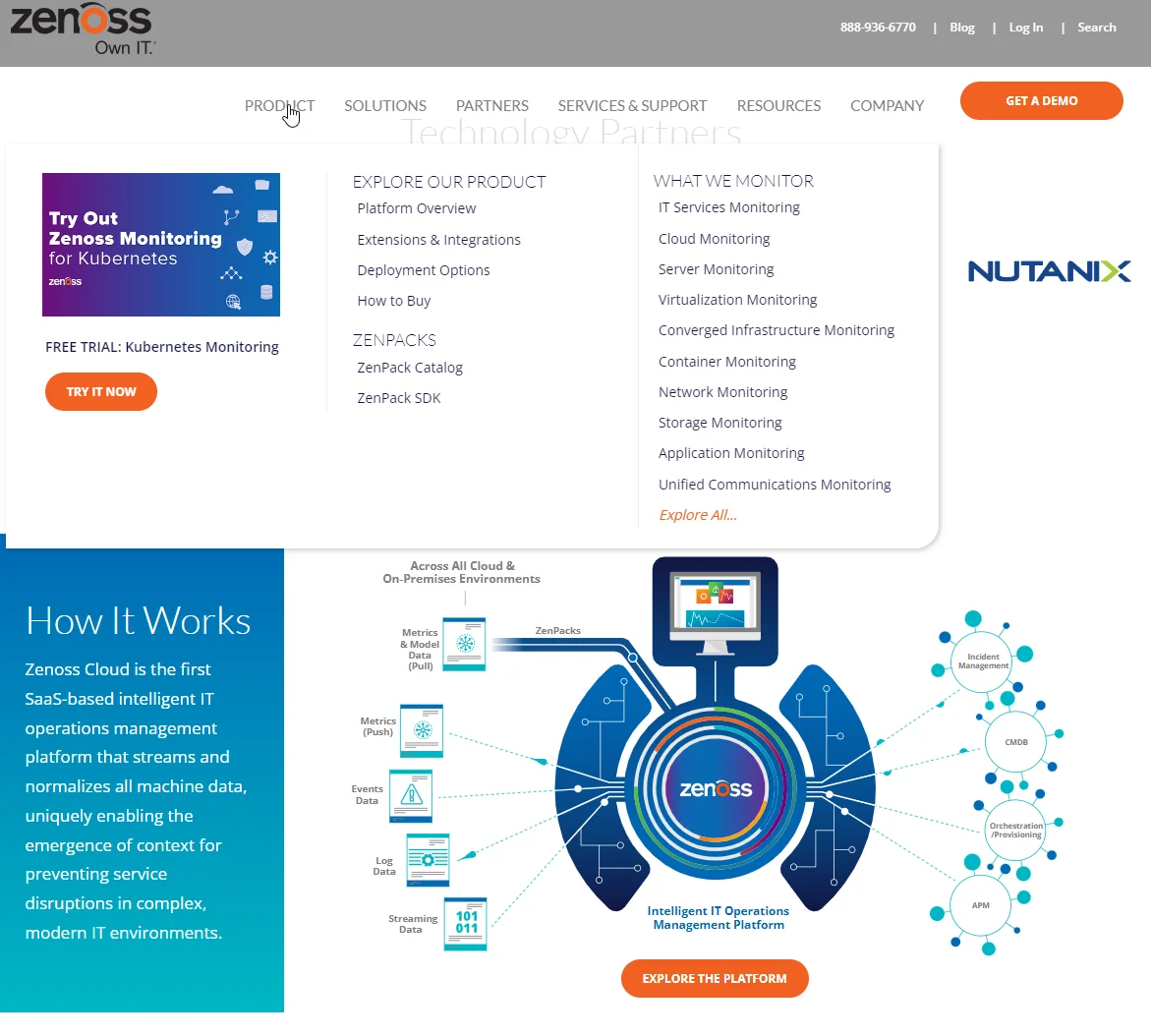
Zenoss Cloud AIOps tools help your IT operations process diverse data types, including metrics, logs, events, and dependencies. This translates into real-time anomaly detection and proactive fault management. Also, look forward to faster root cause analysis and automated incident responses, significantly reducing downtime. Its focus on continuous learning from operational data can improve predictive accuracy.
Zenoss Cloud is best for small, medium, and enterprise players, and its pricing also reflects this.
Zenoss Cloud’s pricing model follows a customized, subscription-based approach. Charges typically depend on the number of monitored devices, infrastructure size, and additional features or integrations you need.
14. IBM Cloud Paks for AIOps – Application performance optimization platform for enterprise cloud environments
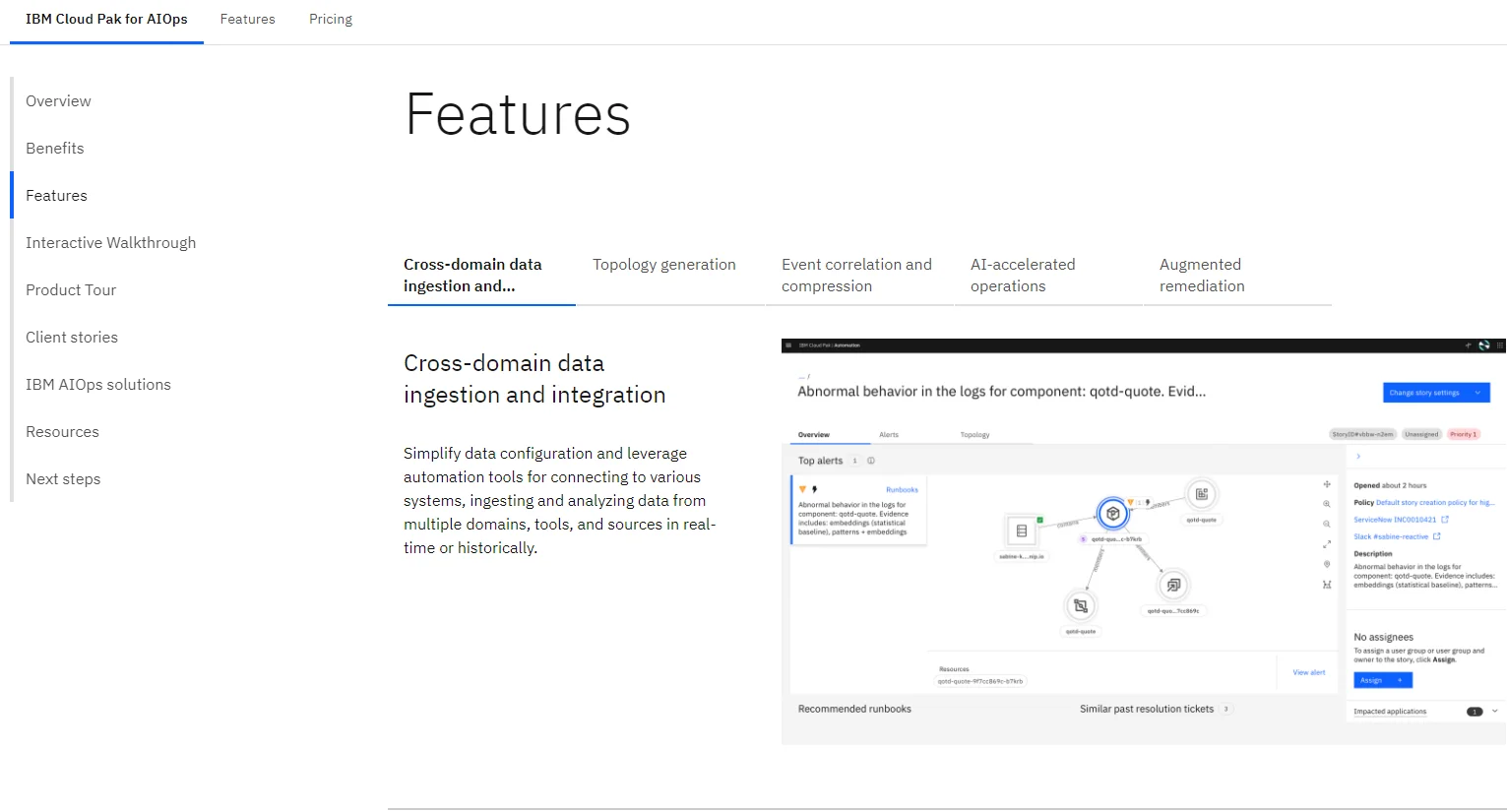
IBM designed Cloud Paks specifically for ITOps (IT operations teams). Cloud Pak for AIOps is application-centric and automates incident management with scalable operational visibility. Expect proactive recommendations and context-aware insights, enabling faster issue resolution. It also automates provisioning and resource management, streamlining your IT operations and reducing costs.
IBM Cloud Paks is best for organizations seeking a solid ITOps platform with native integration with many IBM tools.
Pricing for IBM Cloud Paks is not publicly standardized and typically follows a custom quote model. However, factors such as the scope of deployment, integration needs, and the specific Cloud Pak modules you use influence the pricing.
15. Sematext Cloud – Comprehensive solution for metrics and events collection
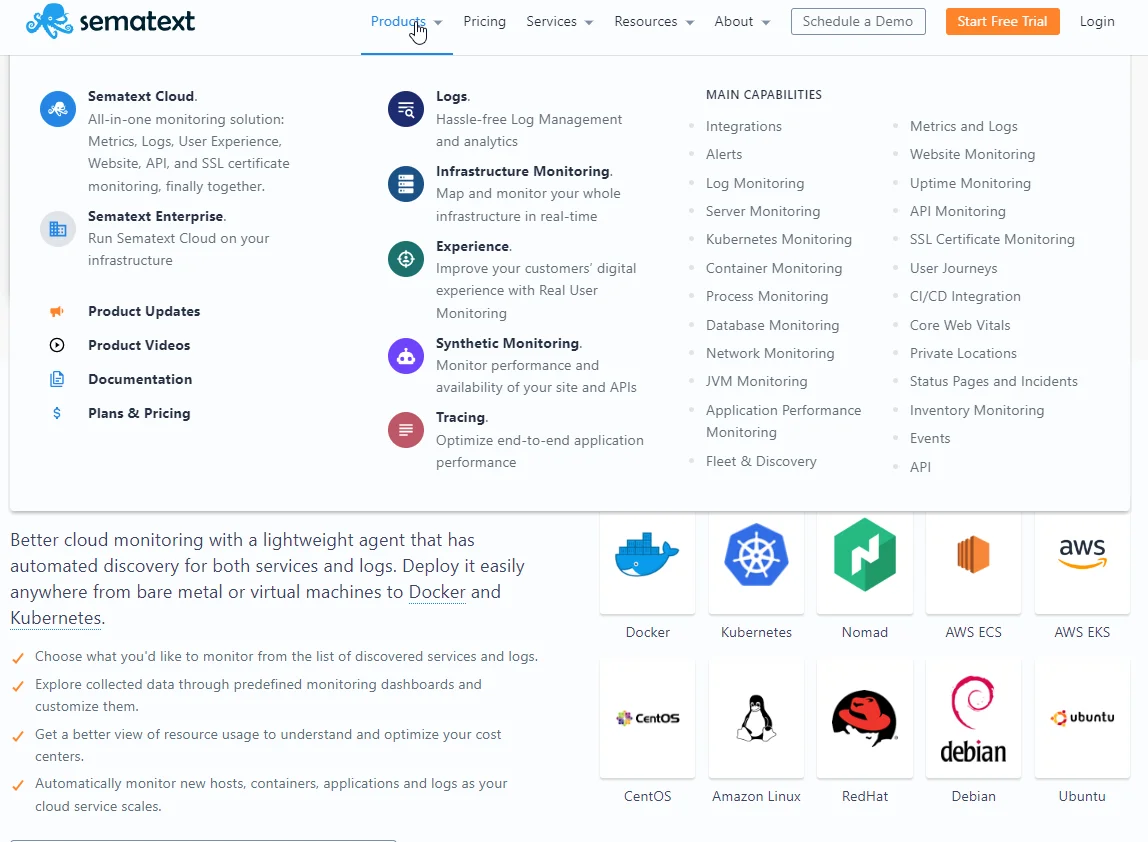
What you’ll likely like most about Sematext Cloud is its full-stack observability capabilities. Like Datadog and New Relic, it seamlessly integrates metrics, logs, and events across diverse IT environments. Public, private, hybrid, or multi-cloud? No problem, it’ll cover you.
Yet it’s also user-friendly, powered by its auto-discovery tool and over 100 integrations (without manual setup). Other capabilities, like robust anomaly detection and intelligent alerting, reduce alert fatigue by correlating events to identify root causes.
Sematext Cloud is best for IT operations teams with dynamic cloud environments to monitor and optimize. It is a top Datadog alternative as we shared here.
Sematext Cloud pricing is flexible and usage-based for its AIOps capabilities. You pay for the features you need, such as log, infrastructure, and synthetic monitoring. Cost factors here include data volume, retention periods, and host counts. Additionally, tiered plans offer additional features like extended data retention and higher daily data ingestion limits.
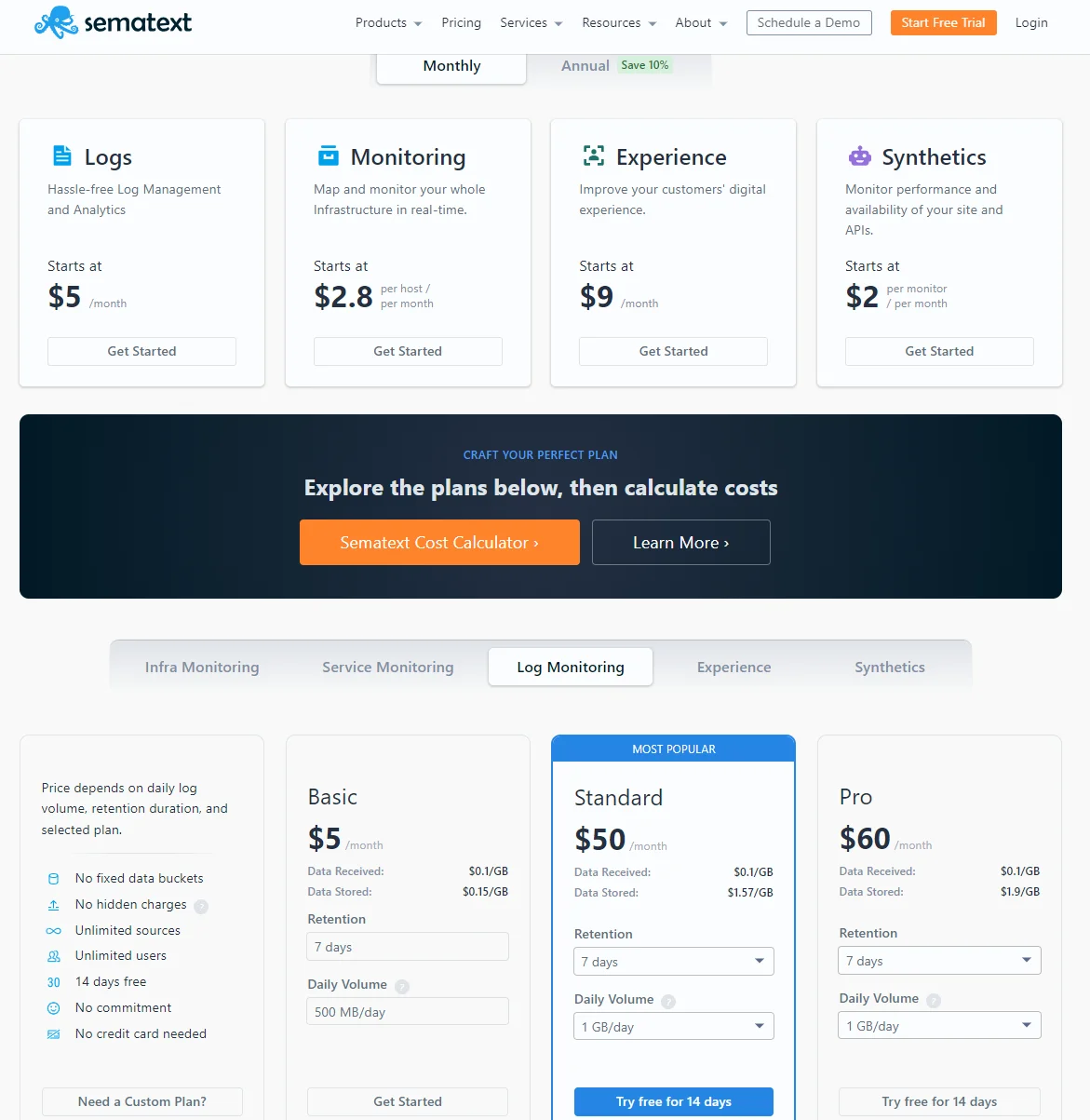
Bring Engineering-Led Optimization To Your IT Operations
Take your time to consider each of these AIOps tools. But if you are more concerned about runaway cloud costs, a less-than-impressive cloud ROI, and constantly worrying about surprise cloud bills, you’ve come to the right place.
With CloudZero, you get precise cost insights that help answer questions about who, what, and why your cloud costs are changing. To get specifics, you can zoom into unit economics, such as Cost per Customer or Cost per Feature.
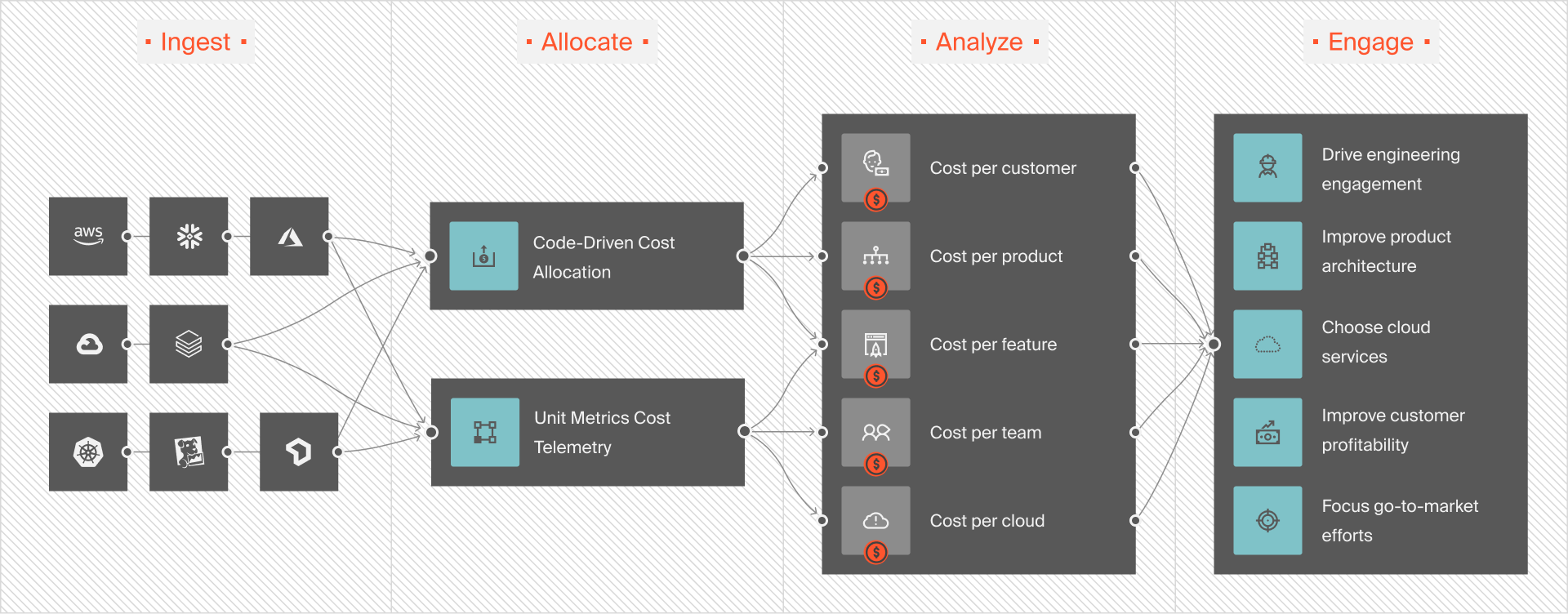
Yes, this means you’ll know almost immediately what to do next.
Plus, you get cost anomaly alerts in your inbox to keep surprise costs away. CloudZero customers say it pays for itself on average within three months.  to see for yourself.
to see for yourself.
AIOps Platforms FAQs
What is the difference between AI and AIOps?
AI refers to the broader field of artificial intelligence technologies that apply across various domains. Meanwhile, AIOps specifically applies AI techniques to automate and improve IT operations (tasks like monitoring, event correlation, and root cause analysis).
What is the difference between AIOps and DevOps?
DevOps focuses on improving collaboration and automation in software development and delivery processes. These processes include Continuous Iteration and Continuous Delivery (CI/CD). With AIOps, the focus is on using Artificial Intelligence and Machine Learning to automate IT operations, such as proactive incident management and resolution.
What is the AIOps framework?
The AIOps framework is a proactive approach that leverages advanced Artificial Intelligence and Machine Learning to automate IT operations processes, such as root cause analysis, by analyzing vast amounts of data from diverse sources in real-time.
